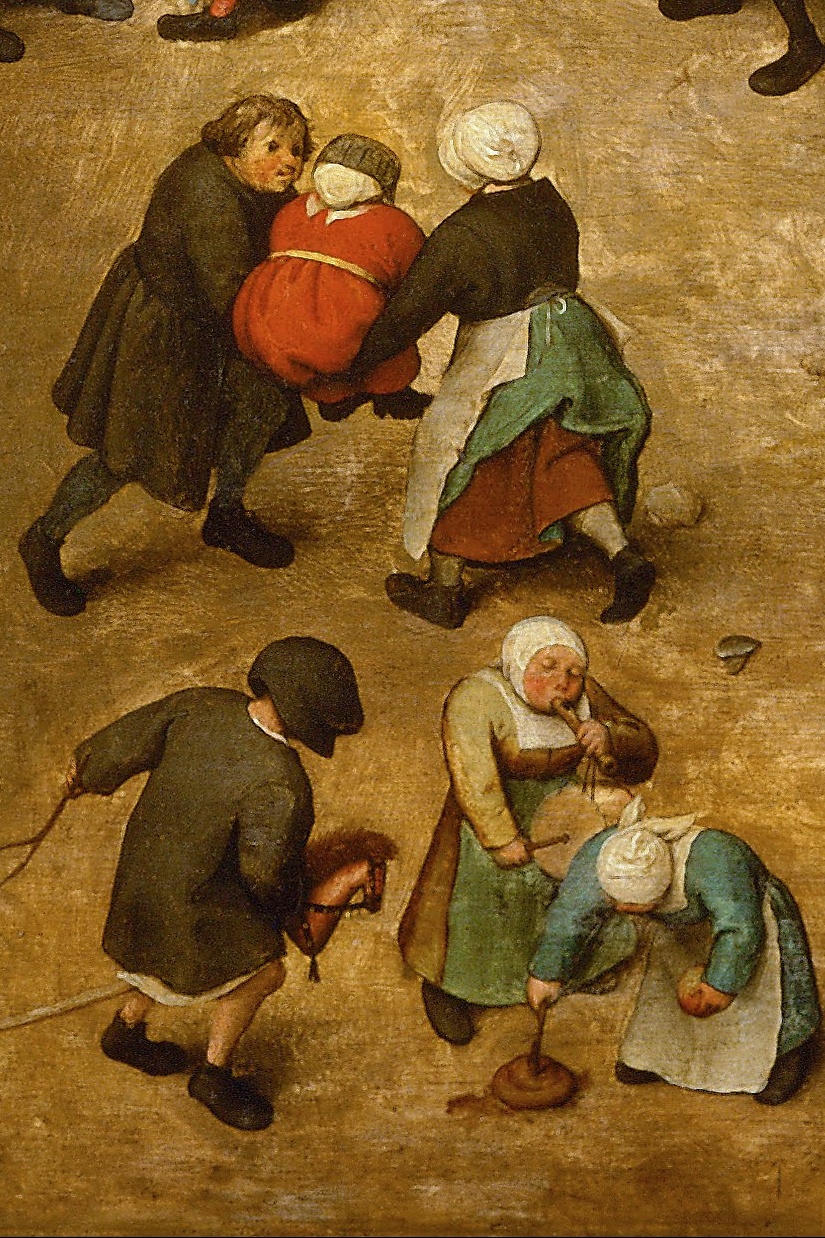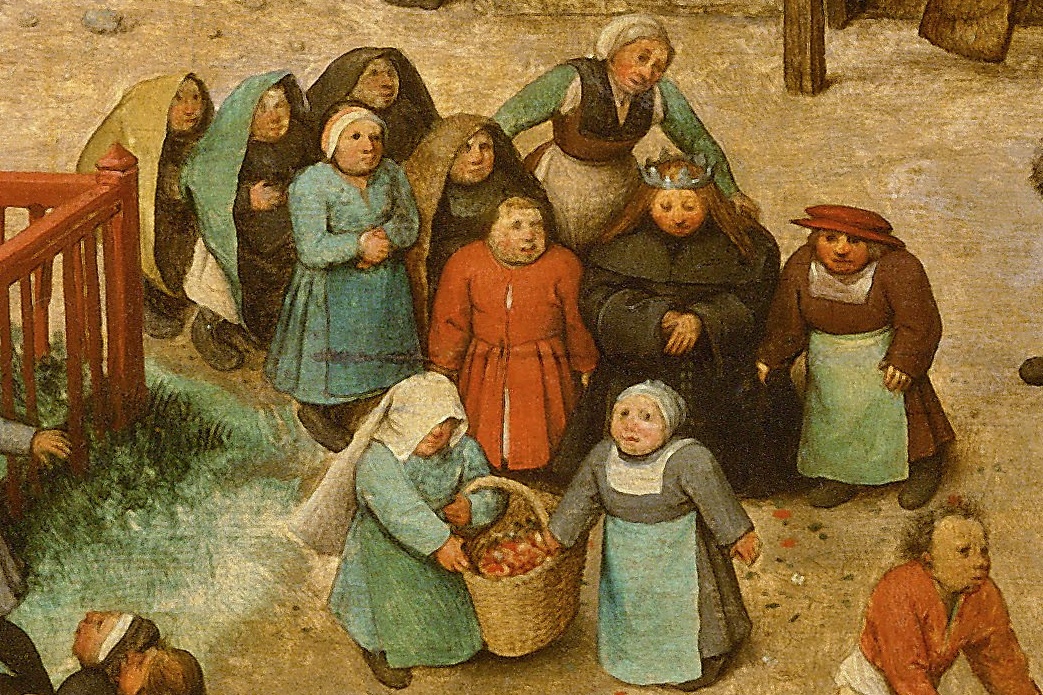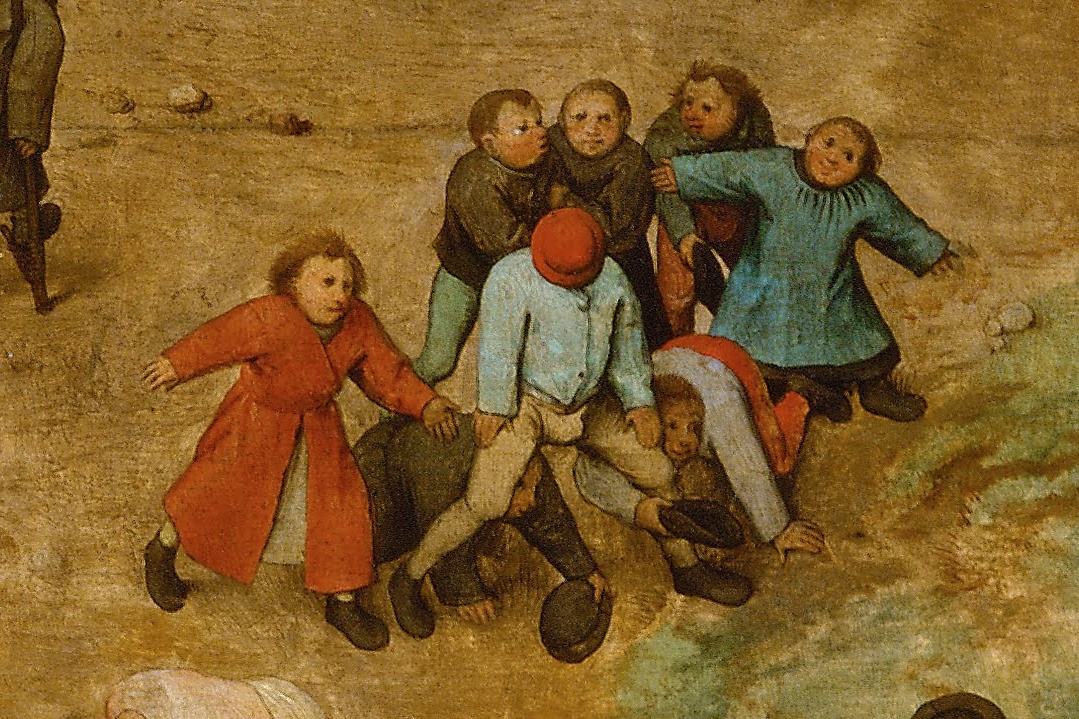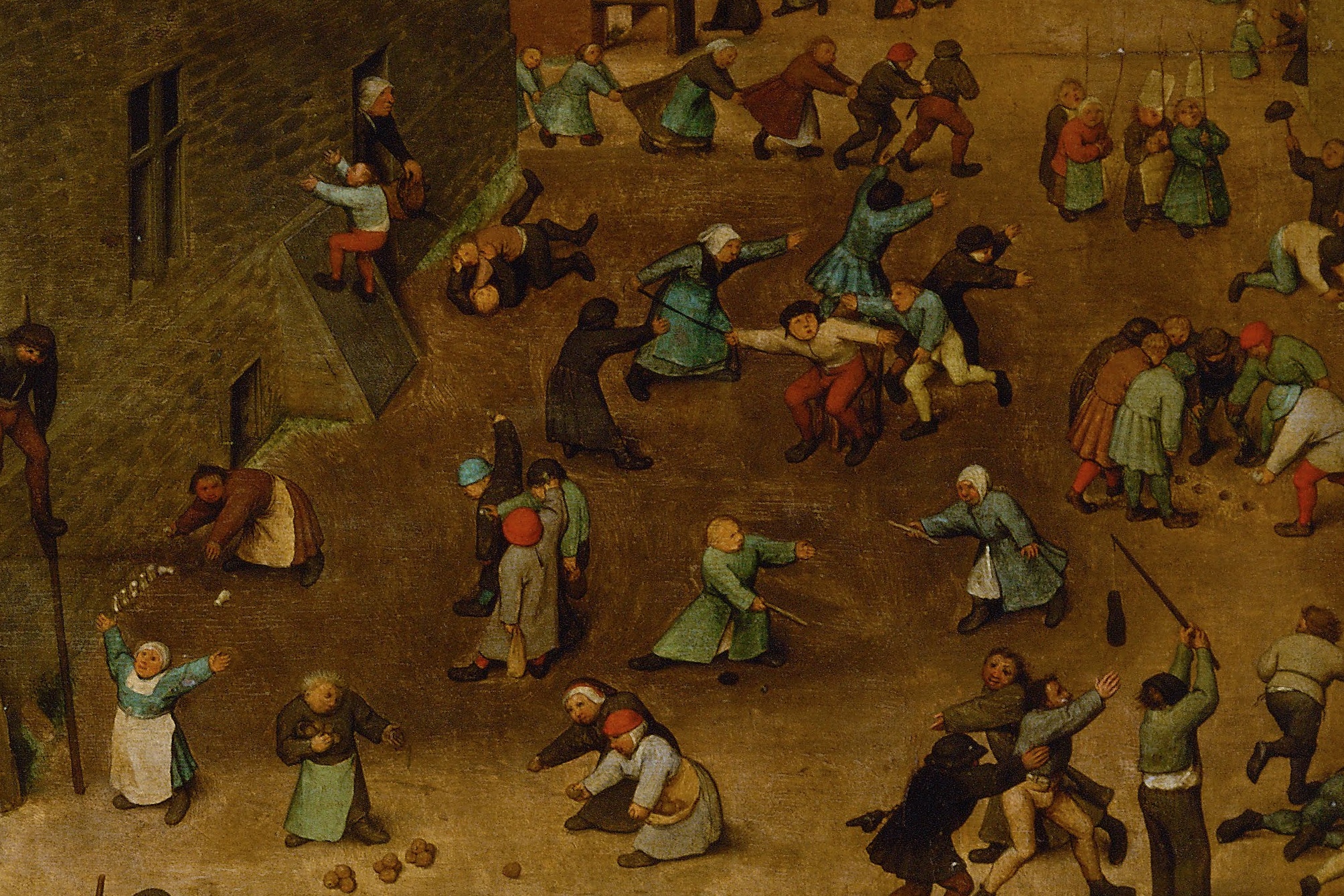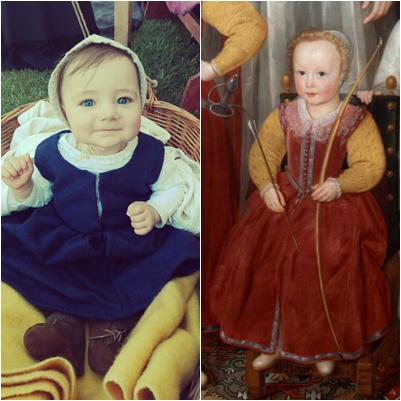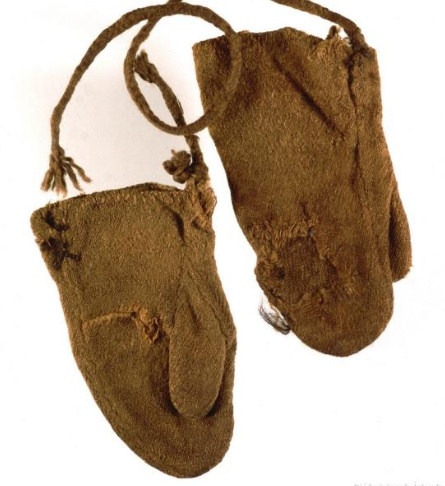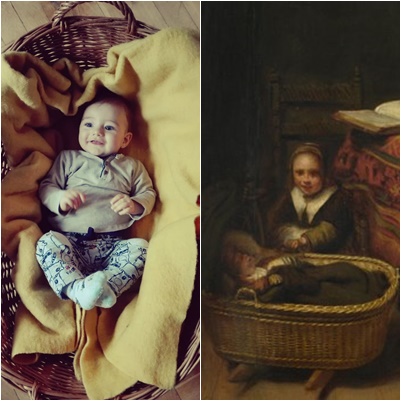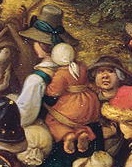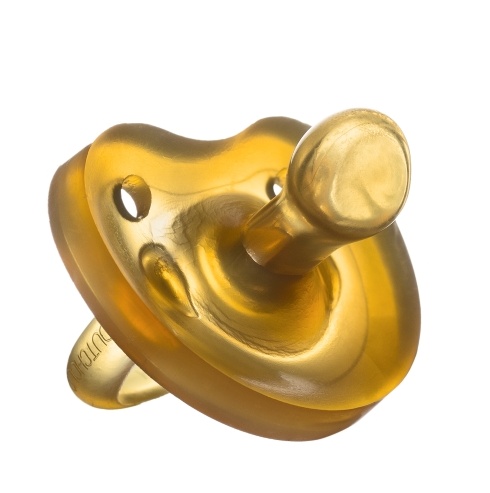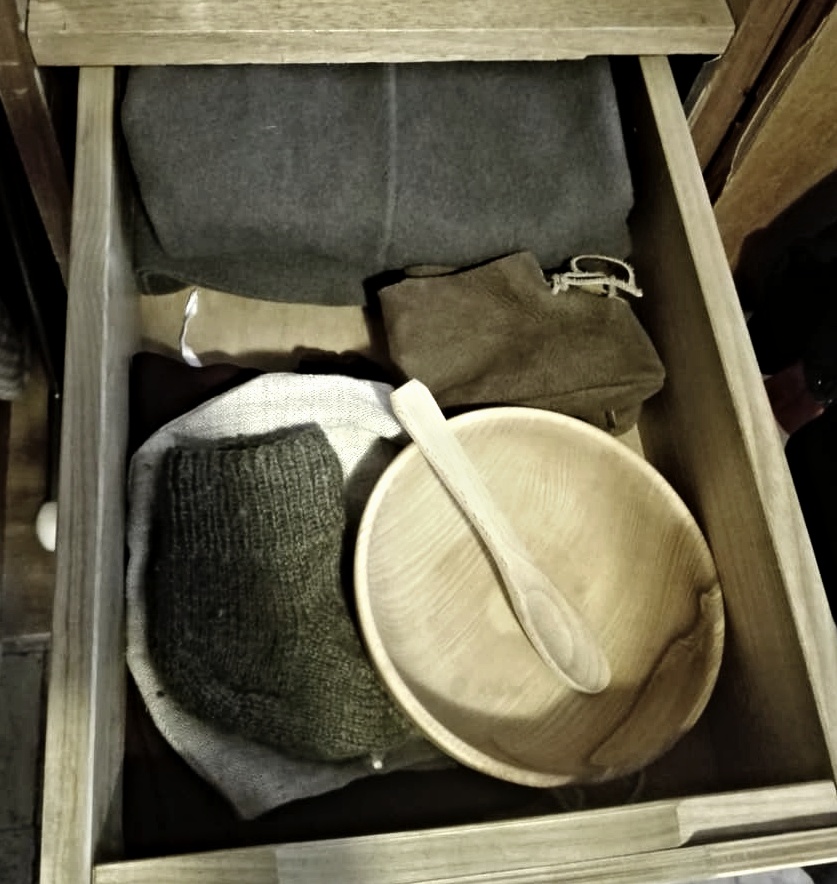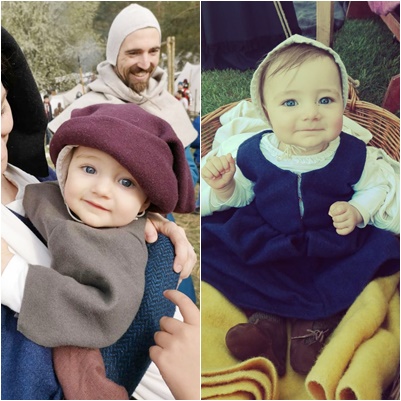
When we were approaching our first event with our baby, he was 9 months old. It was the Battle of Libušín, which my husband and I always attend in the costume from the second half of the 15th century. I wanted to have the baby clothes as historically acurate as possible, which, given the availability of information about children's clothing in the 15th century, is not so simple. Of course, I was based primarily on illuminations, because what my eye can't see, my head doesn't believe.
Since it is usually cold at Libušín and it traditionally rains there, I had to choose something really warm due to the lack of thermoregulation of the baby. Fortunately, the fabrics for these mini costumes are and will always be enough in the current state of constant sewing of historical costumes. The warmest thing we had at home is a tough, gray-brown wool, 800g. The rest of what we had from it at home was just about enough for a little costume. So the first thing that was made was a practical little dress for a baby boy who was just crawling and walking around the furniture at the time.
In less than a month, we were attending the traditional Wallenstein Celebrations in Frýdlant, and of course I was wondering whether it would be possible to combine a costume from the 15th and 17th centuries a little, to be able to make the first children's historical equipment in time. Although some non-historical clothing is quite tolerated in our historical group when it´s a child, I don't like it and I resisted it. However, I found that some elements of children's clothing were indeed "in fashion" from the late 15th century to the mid-17th century. And so, in the end, I made a fairly accurate historical compromise, aware that soon my baby would grow out of my compromise and I´ll sew a new costume again. Of course, the effort was to preserve as much authenticity as possible, but I also kept in mind the safety of the baby, who sucks and nibbles on everything, so I couldn't use soft wool, which the baby could nibble on and bite a piece off and suffocate, or woolly buttons that could be bit off, etc. In the end, our quite safe first child outfit was created for both the 15th and 17th centuries, with some combinable elements stemming from the balance between a caring mother and an enthusiast of everything that is as historically accurate as possible.
What did I want to achieve?
A coat
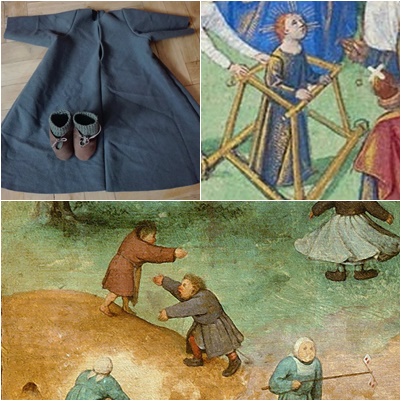
Warm coat for a 9-month-old boy, a 15th century detail on the right - boy with walker in long-sleeved dress and below Bruegel's depiction of 1560 children with different types of dresses of a similar style, the types differ in closing, some are closed, which were threaded over the head, some with slits, some without, with or without straps and belts... And of course, regardless of whether it is a little girl or a boy, young children wore all dresses up to a certain age.
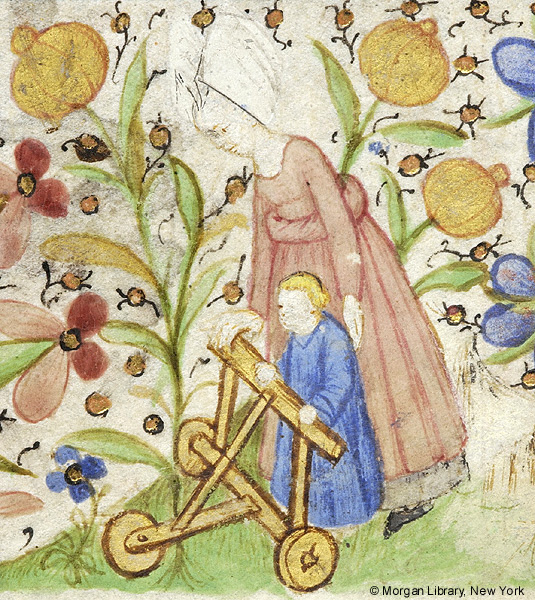
Book of Hours
A similarly old baby boy in similar clothes.
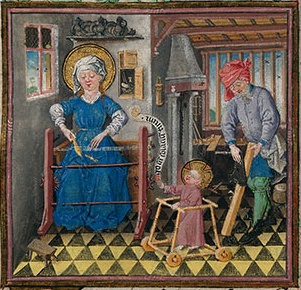
The Hours of Catherine of Cleves
Baby Jesus in the Walker.
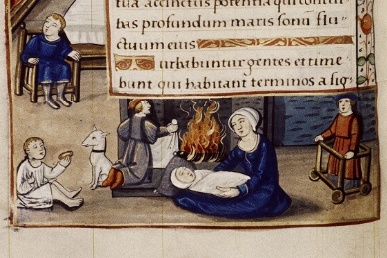
Book of Hours
Detail of children dressed in similar dresses.
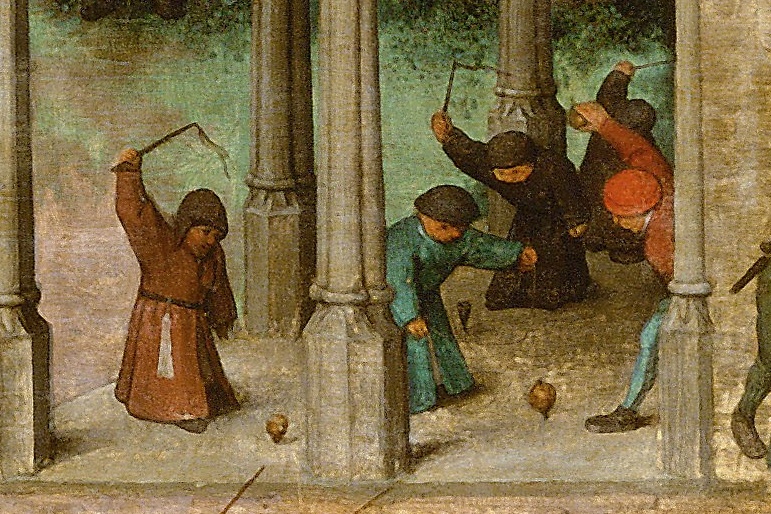
BRUEGEL, Pieter the Elder. Children's Games
Detail from Bruegel.
Step by step
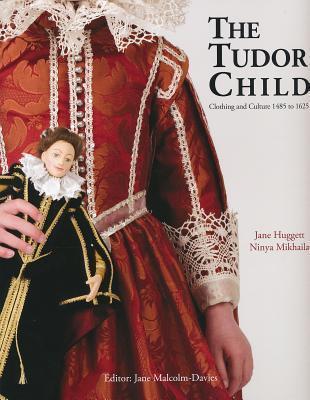
Because any sewing of historical costume in our home is preceded by several months of studying the subject, I ordered the book The Tudor Child for this occasion, which is devoted to the period we need exactly - 1485 to 1625. This book opened new horizons for me. The text depicting the basic clothing for the newborn up to adolescent contains a complete wardrobe with all accessories that have been carefully reconstructed and described in the publication. The bonuses are charts showing the historical extent to which the thing was worn, in what social status and how many documented depictions we have of the given element. Of course there are also patterns on the measuring net in inches.
A coat
I created a pattern for the coat according to the pattern for an 8-month baby, which I enlarged slightly so our child could wear it longer and I would not have to sew a new one after a few months. At the moment he is 15 months old and his coat (and a petticoat) is just right now. (On the attached photos they are both little bigger, photos are taken at 9 months.)
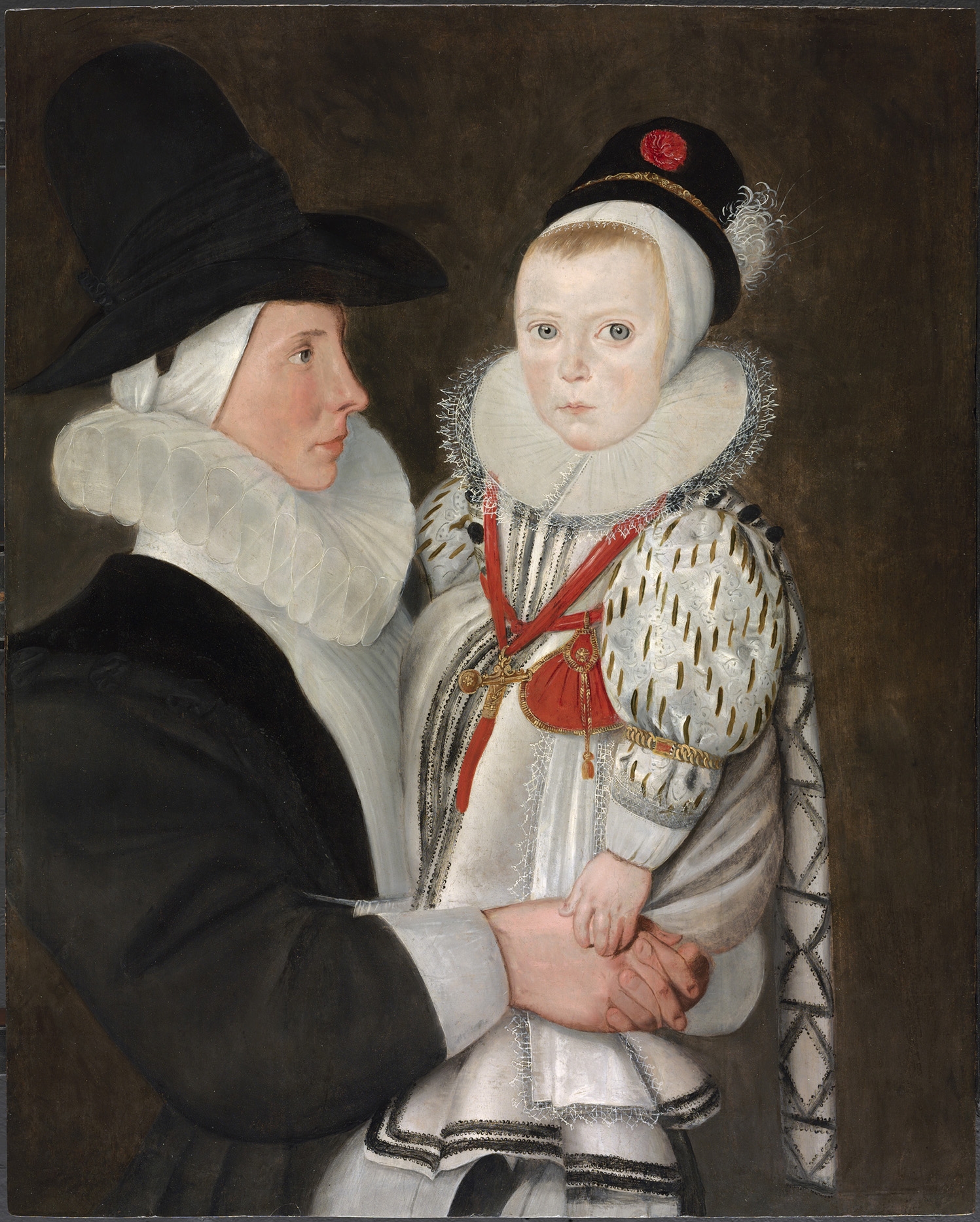
Anon. John Dunch and his nurse Elizabeth Fieldthe Younger
Little John Dunch in a coat, which I slightly edited - I omitted decorating and fitted it to created a "more monolithic" model, more akin to the enclosed illuminations and Bruegel's coats, which are more appropriate for the fashion of the common people. Pattern for a blue petticoat is sewn from a similar pattern, which you can find in the book as the pattern of the pettiocat of the little John Dunch.
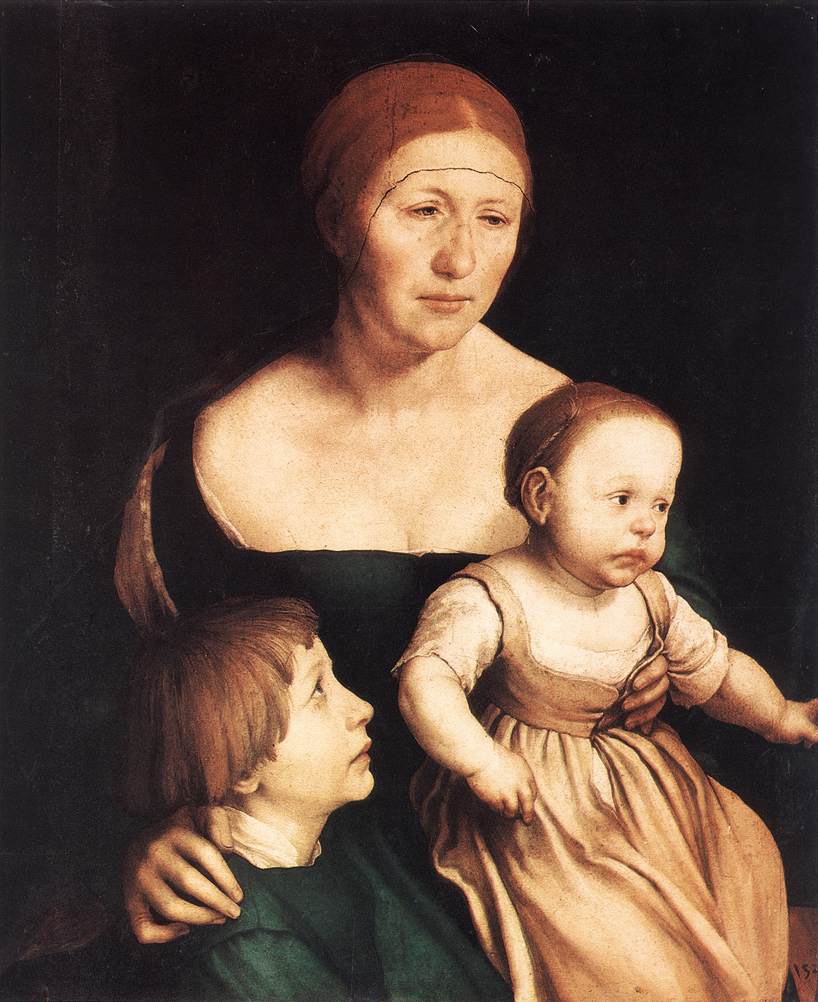
HOLBEIN, Hans. Holbein´s wife and two children
The same pattern of the petiticoat can be found in the picture of Holbein's wife and two children.
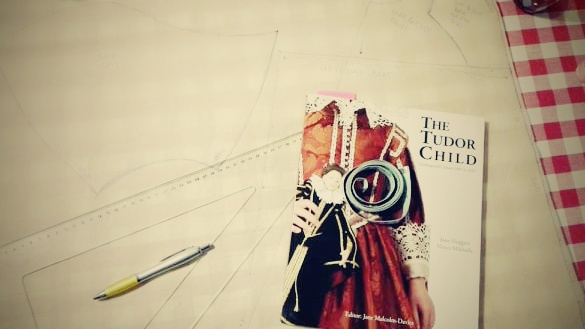
I cut out the pattern of the coat on my improvisation pad, which I drew while I was sewing a "pregnancy doublet". Since then I have been buying a pad, I still do not have it…
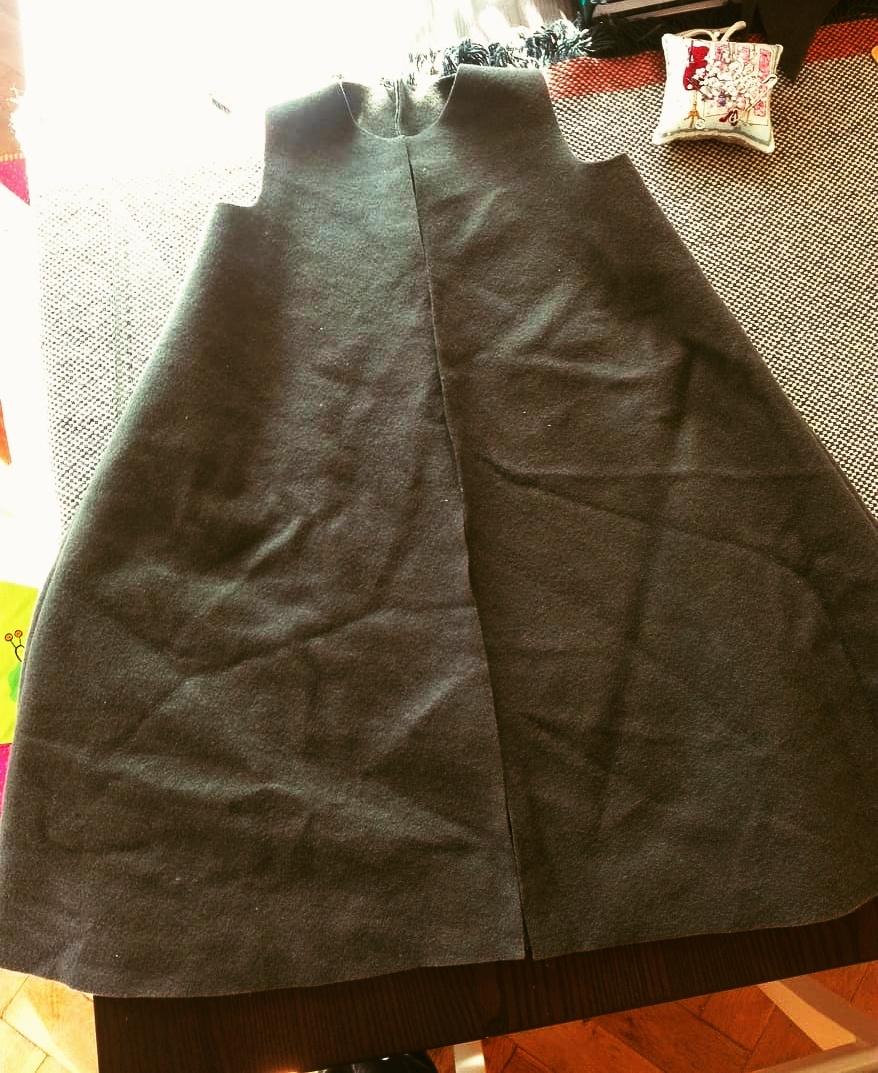
I originally intended the coat to be fully buttoned up along its entire length, which seemed the most practical. Babies hate dressing and undressing (or at least all mothers say that their children hated it as much as mine) and the option without putting the coat over the head seemed the best to me first.
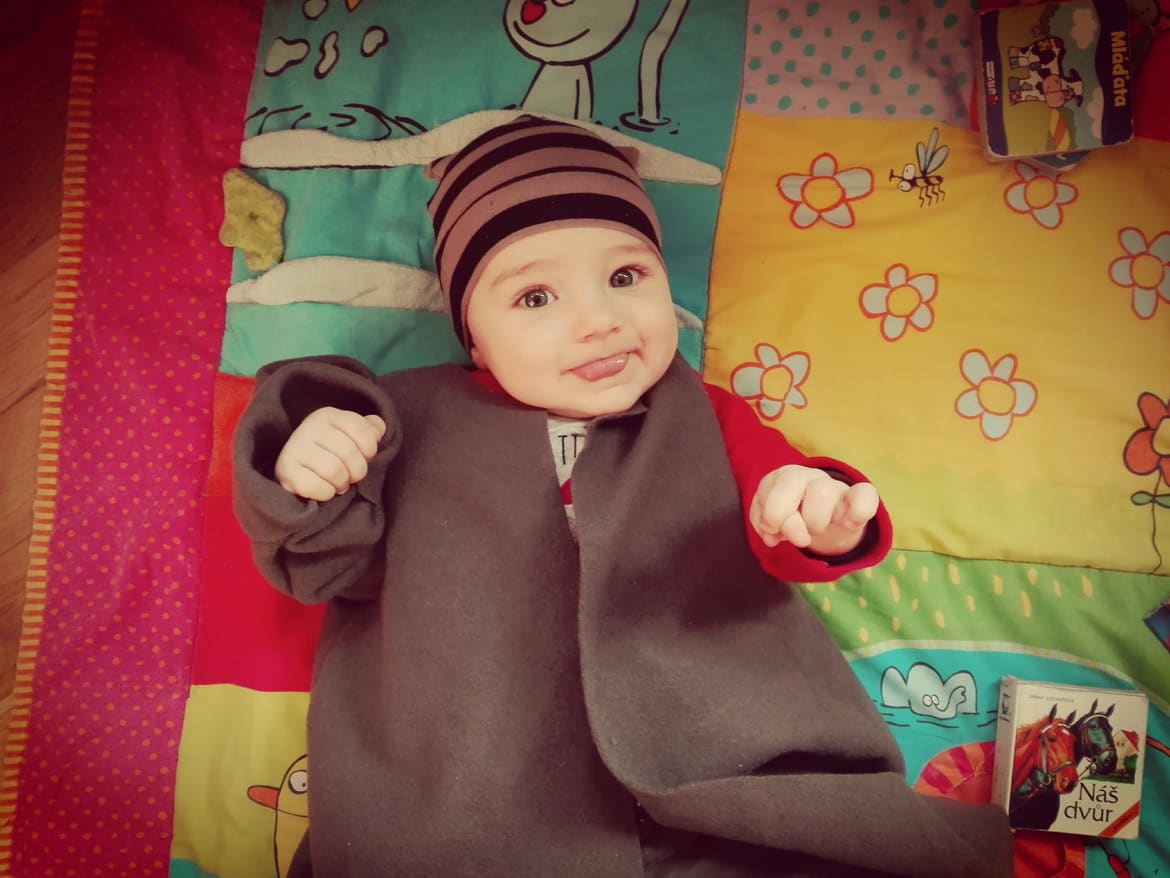
The first try on with one-sleeve coat, which was deliberately a little longer so he can wear it longer.
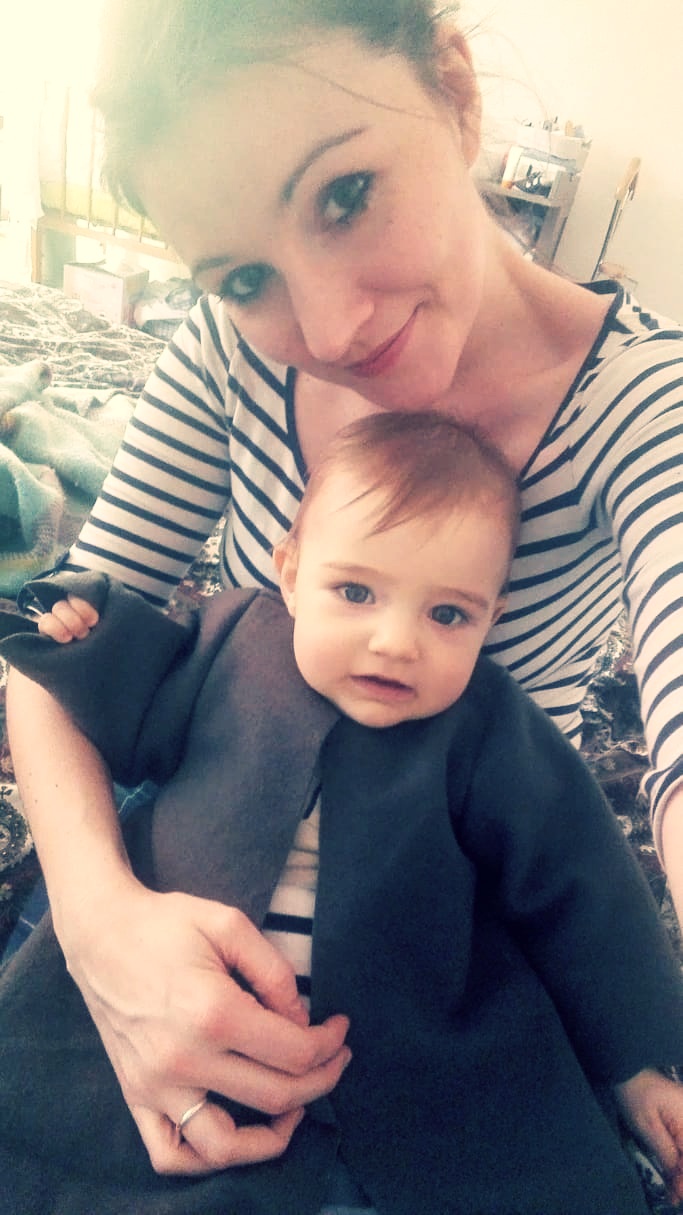
Trying with both sleeves.
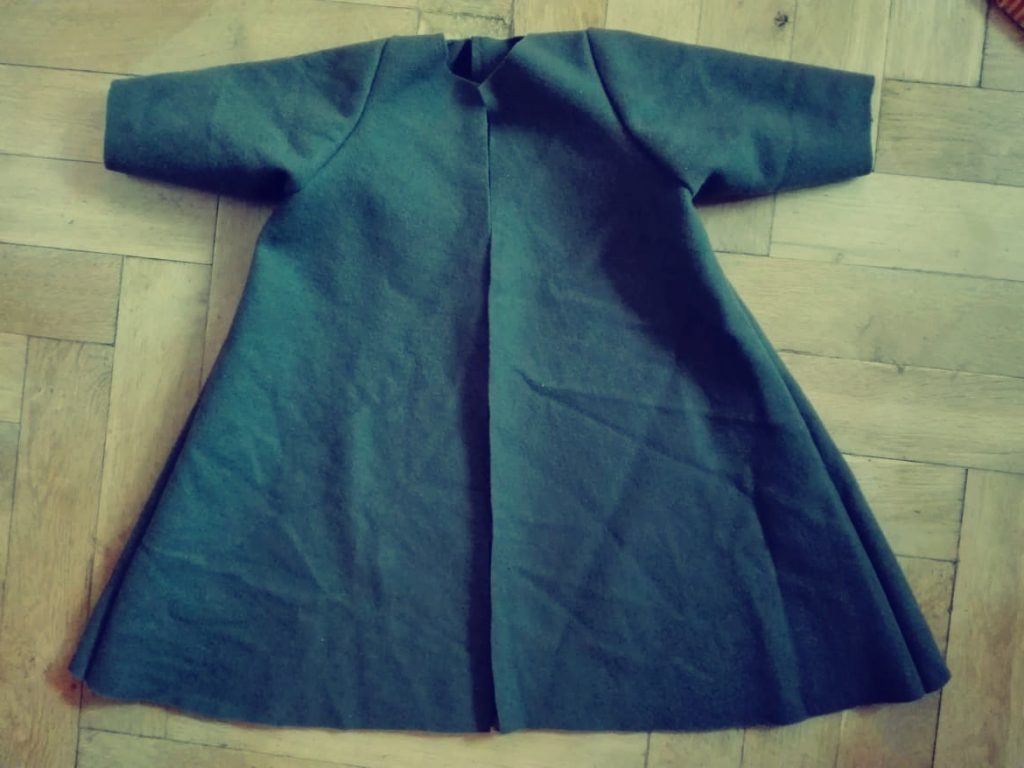
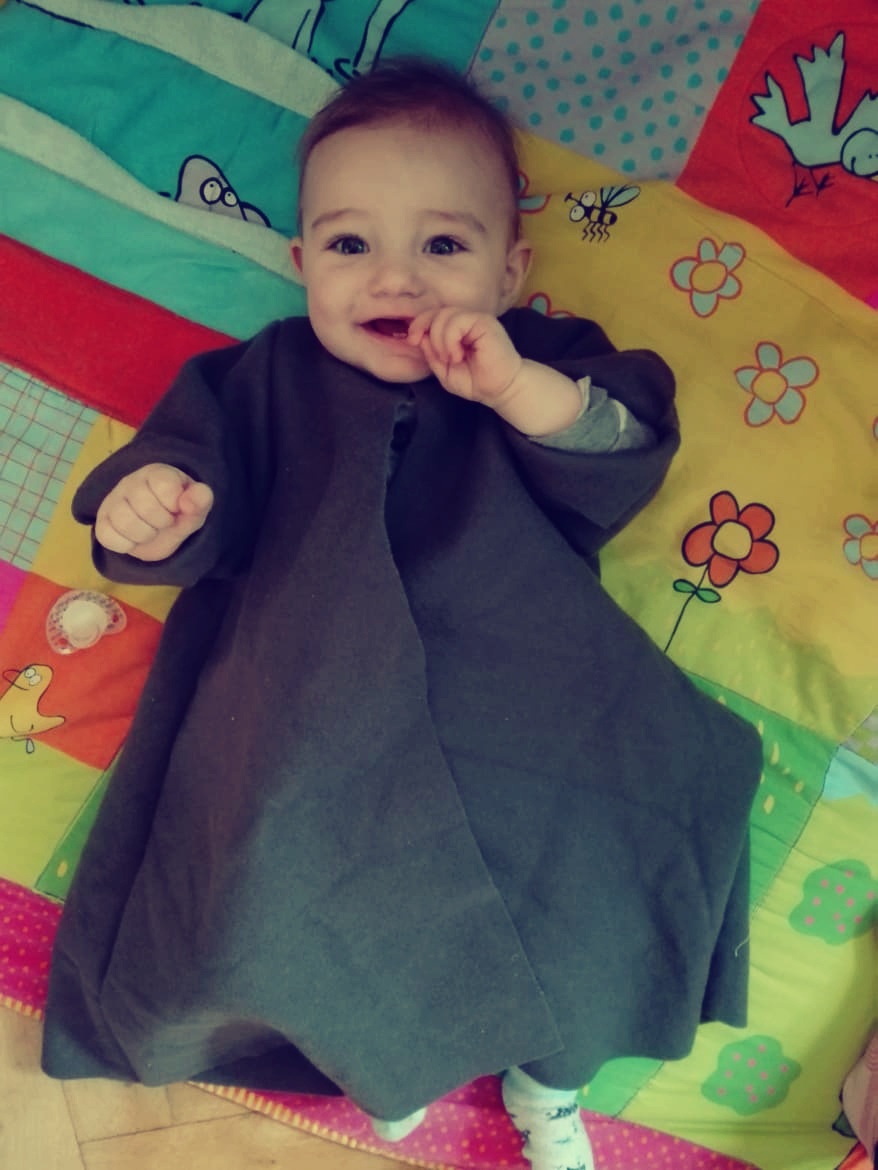
During these tryings, I began to wonder a little bit about whether it was a clever idea to make it with fully opened fastening. I decided to make fastening on hooks, because the firmly stitched and hidden hooks seemed to me as a safer idea than tying the cords or buttoning - they would be easier to jug and bite off - but the coat would probably open with the hooks and the child would constantly chew on brass hooks.

In the end I sewed the coat from the bottom up to the middle of the chest. This gave me a sufficiently large hole for the putting over the head, with which the baby does not get so furious.
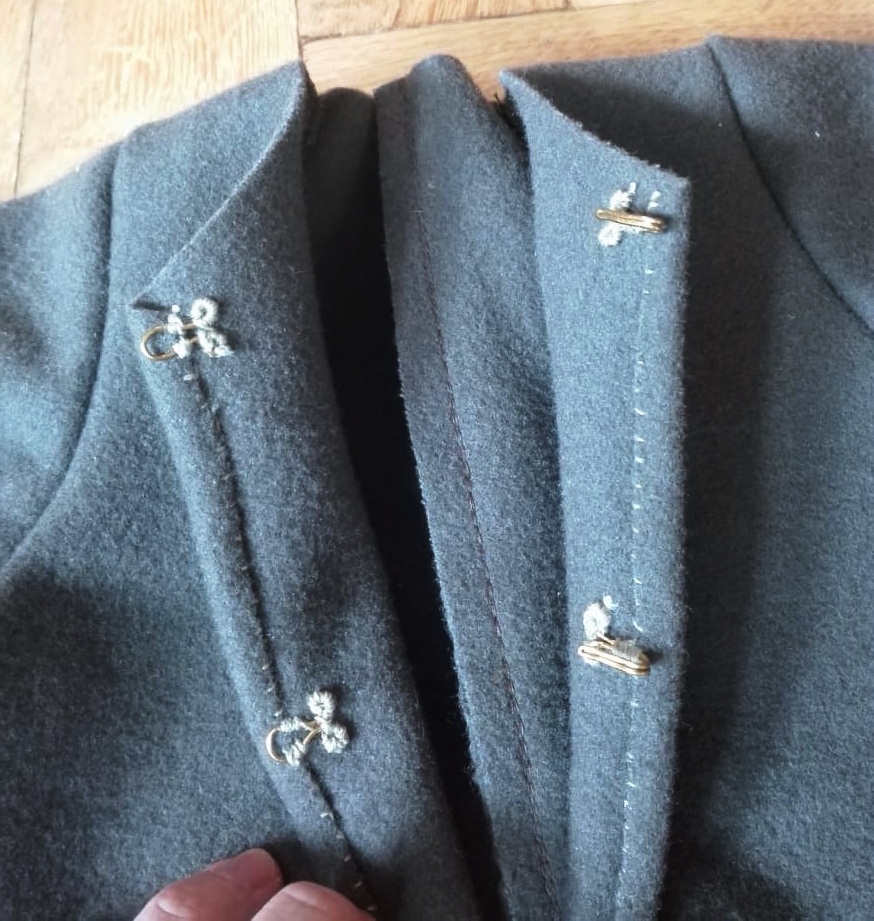
Hooks are tightly sewn at the neckline of the coat, they can hardly be unraveled, and bitten off (I make them from brass). Since the coat is made of really warm and solid fabric, I decided to leave it without lining and I wrapped the edges only where the hooks are sewn.
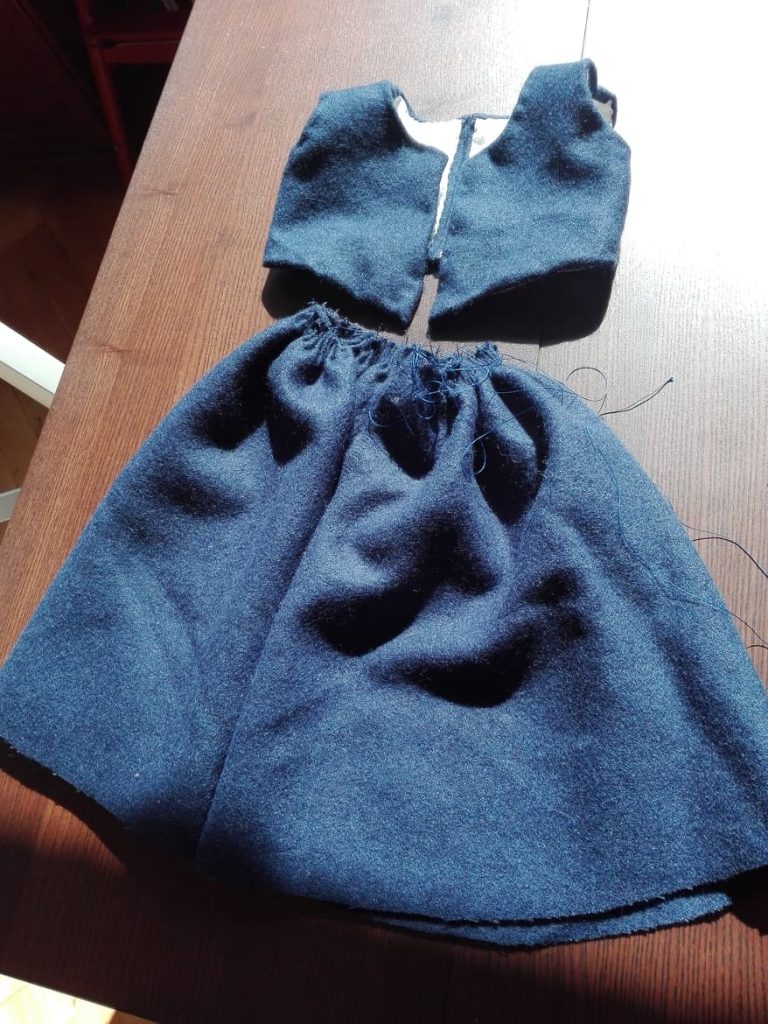
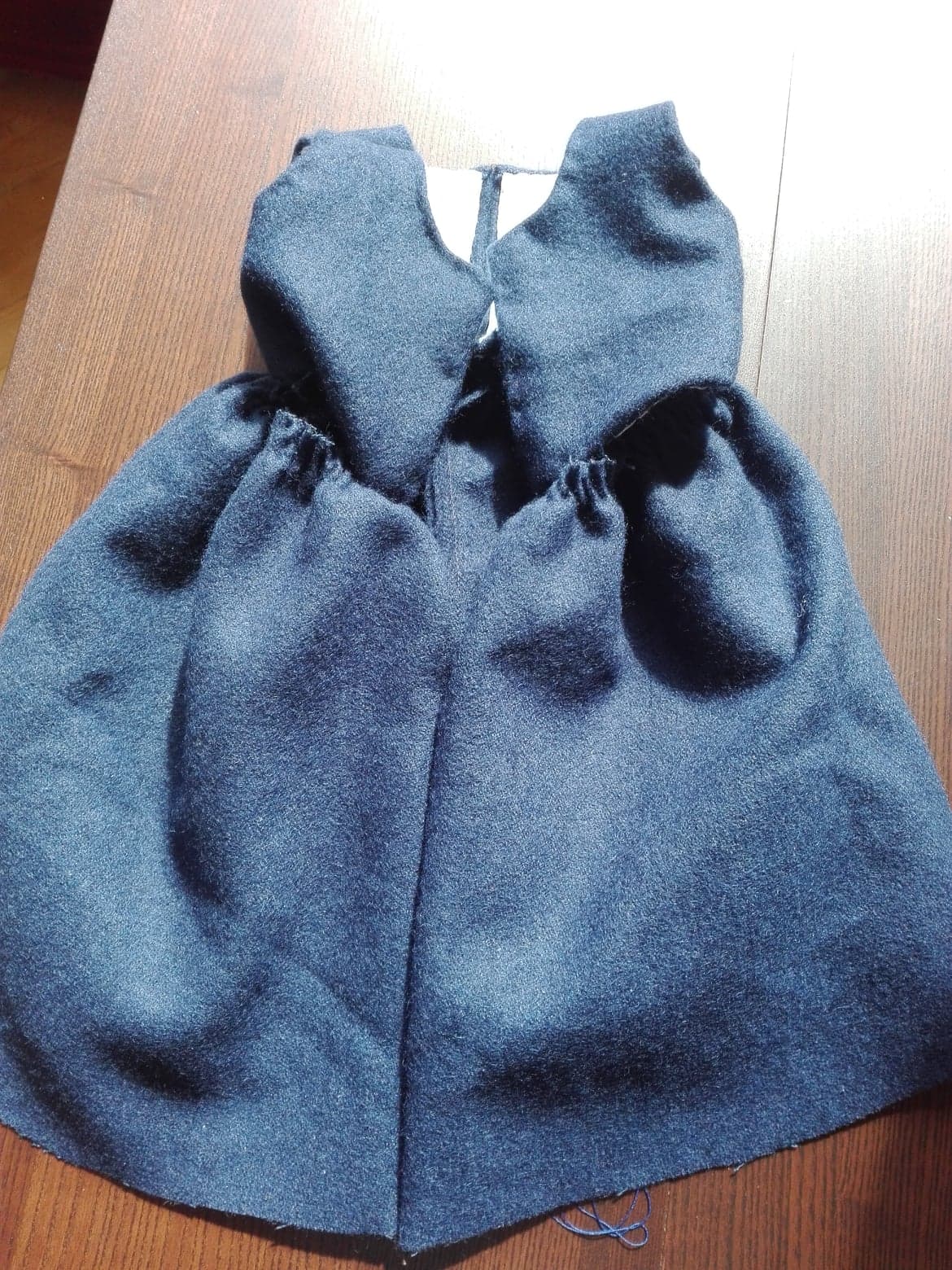
I did not even try putting the baby into the petticoat, after the experience with the coat I made the same size petticoat from blue wool, I lined the bodice with a white linen and chose hooks again as fastening. It took me about 2 hours.
Accessories
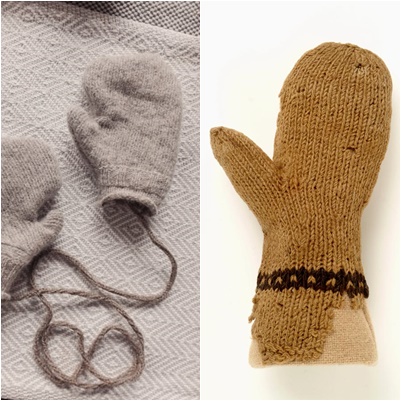
I used the same book of patterns also for accessories – I started with gloves. I admit that I have forgotten how to knitt and because of my passion for sewing, I never came back to it and I am not able to make myslef knitt something. Moreover, I have not yet fully studied the techniques of historical knitting. However, I decided to deceive this detail a bit, so I made these mittens from my old woolen sweater from Benetton and for convenience I cut out and attached the woolen lucet cord (there is no better way how to recycle your favorite sweater). On the right is a comparison with a surviving glove from the Museum of London.
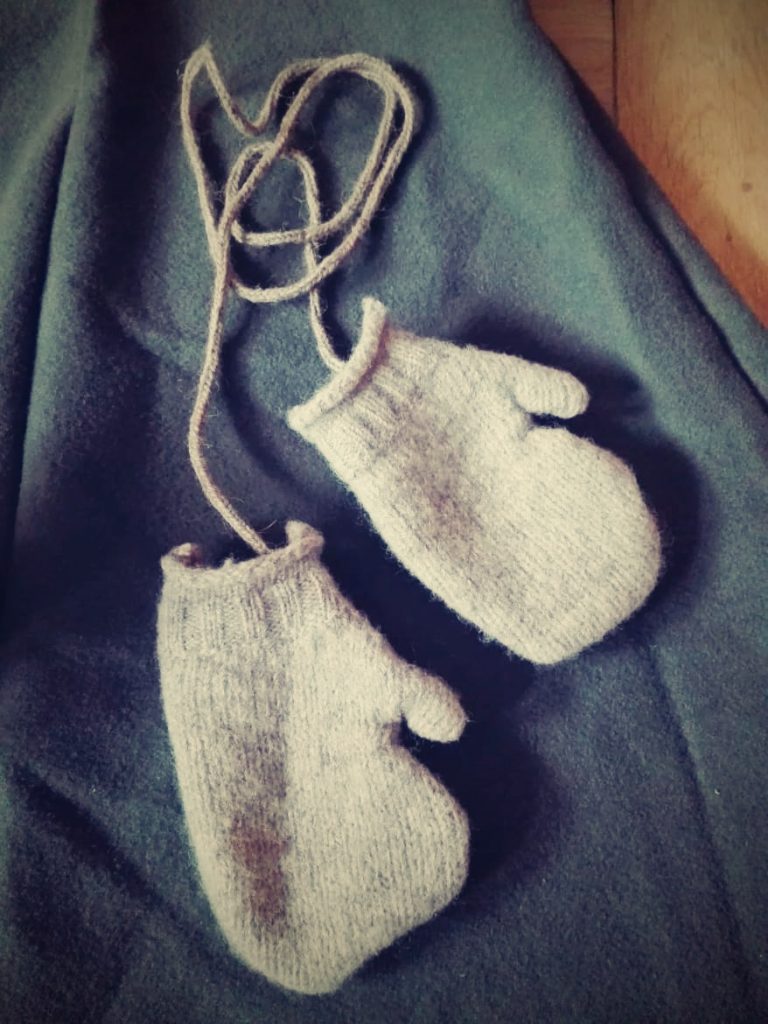
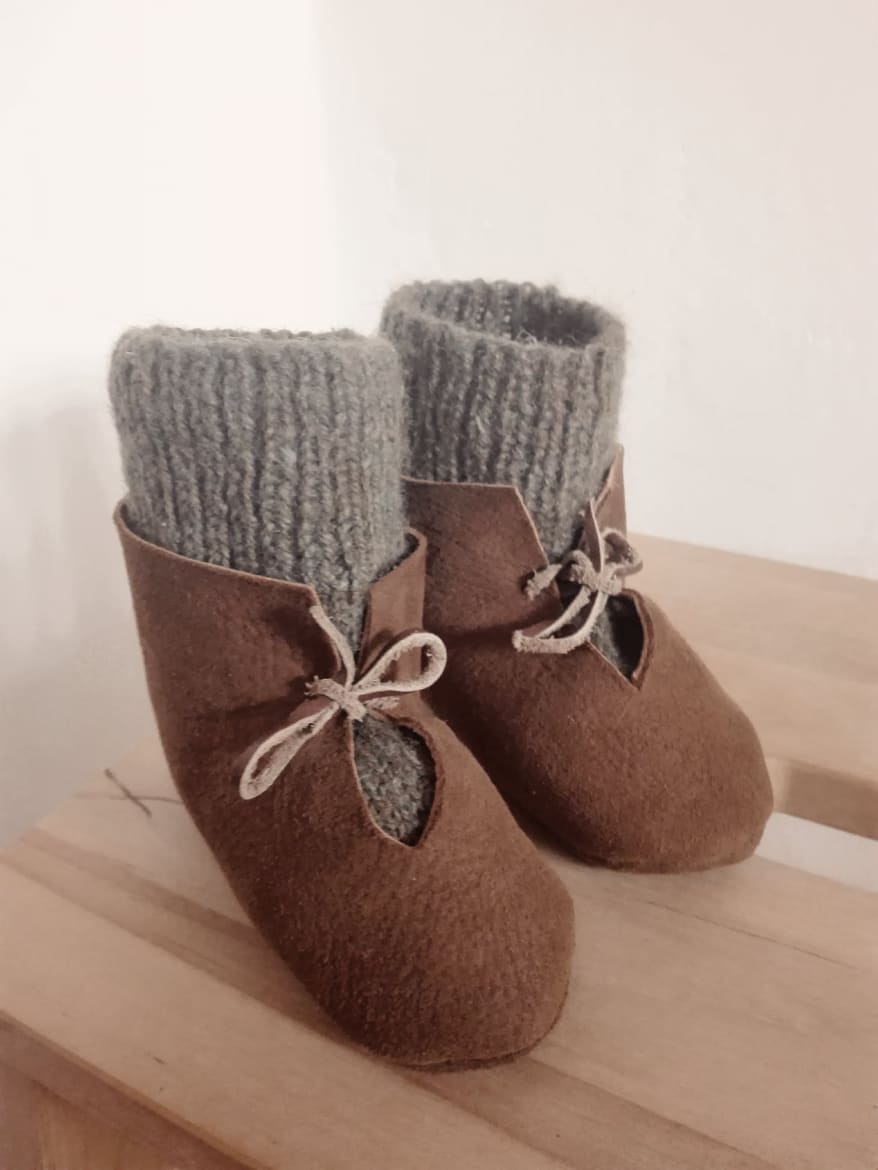
I also used the pattern for infant/toddler shoes.
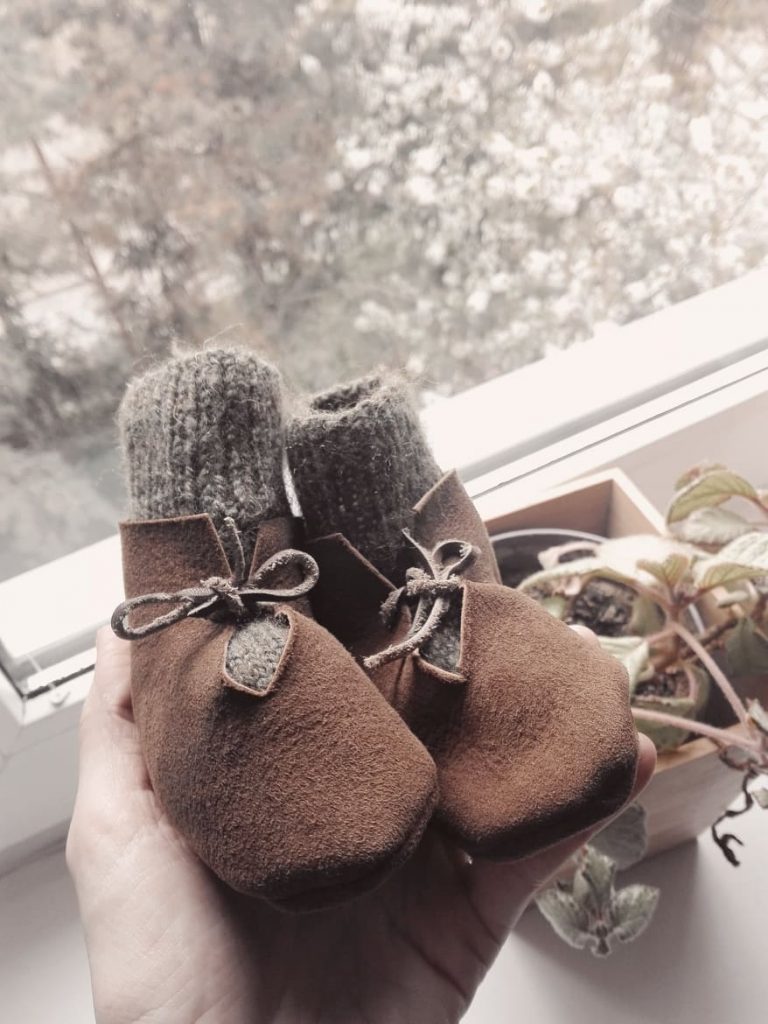

Shoes/slippers for a baby (toddler) were made of a soft leather with the assumption that it would be footwear for a non-walking baby, so I chose the softer leather and omitted the heel reinforcement from the pattern. Did you realise I made a mistake? :) You can find the answer at the end of this article. :)
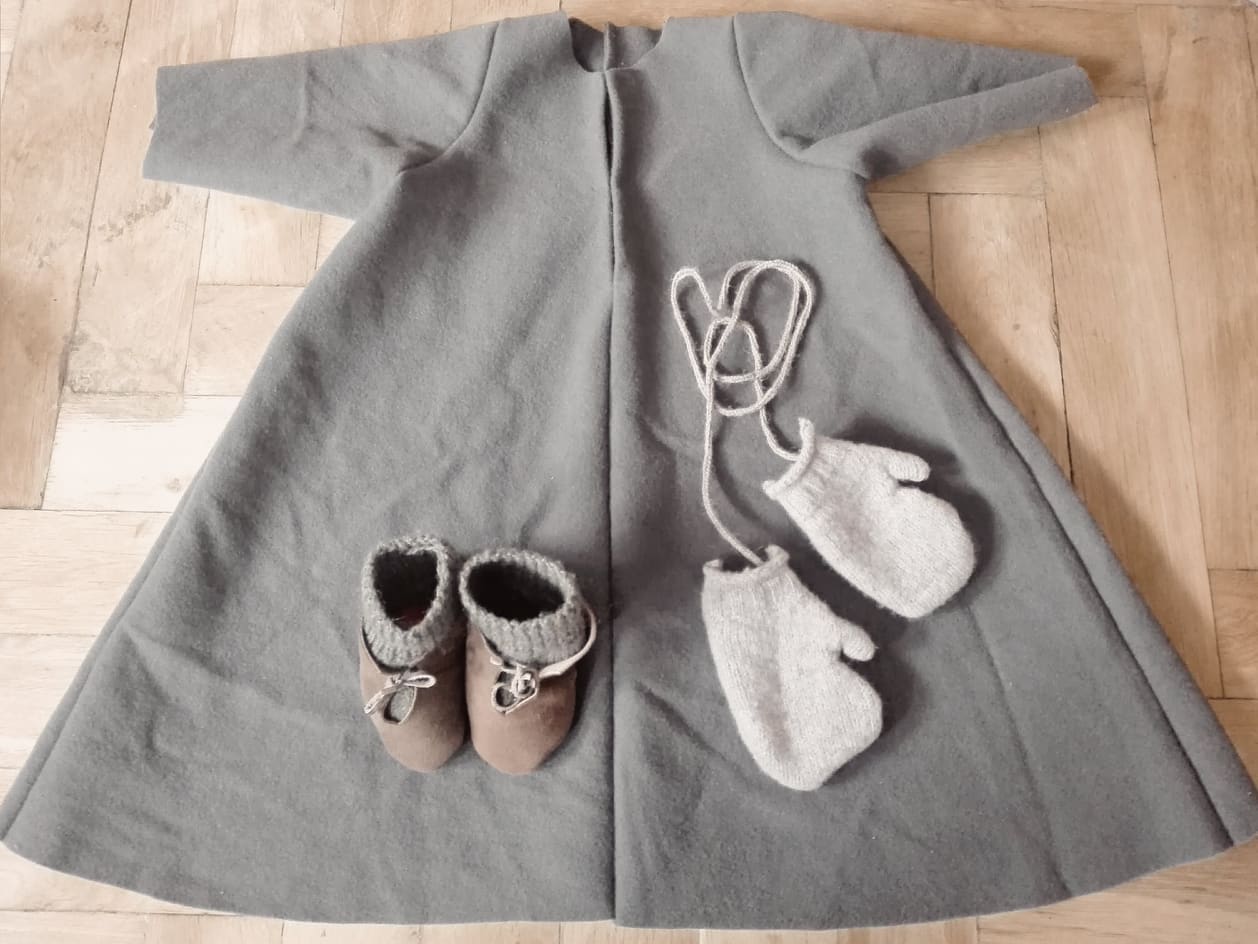
My auntie knitted th green wool socks, so I didn't have to cut another sweater… :)
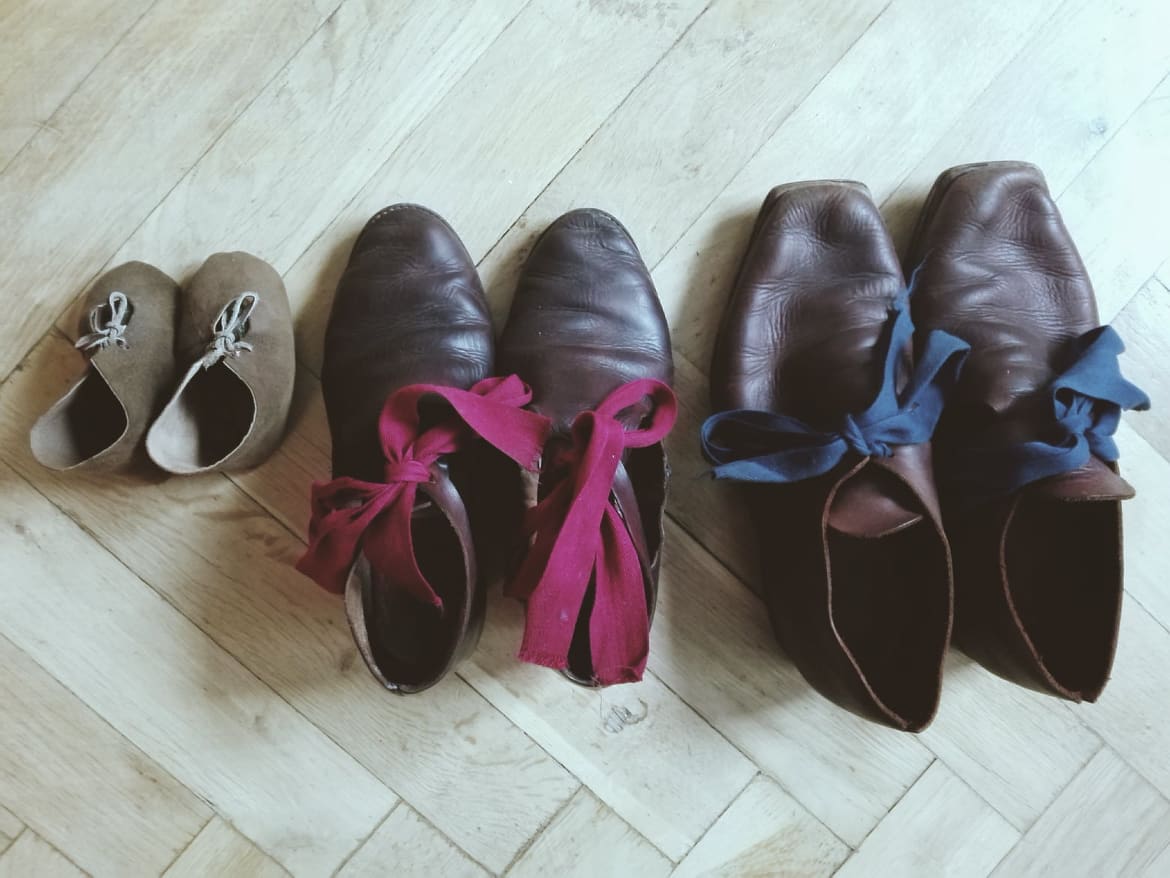
We´re ready.
Then I improvised with the bottom layers. Since I was sewing at the last minute, I did not manage to sew a chemise, so I used some old white chemises that my child inherited from me (so it had a bit of historical authenticity :) ) and I used also cotton white bodies. I wanted to solve the question of stockings by buying some neutral baby tights, but no matter what I was looking for, they all had either the Batman and Spiderman prints or were fluorescent green with stripes. We had some really warm at home, but also striped and with teddy bears. I solved this precarious situation by buying cotton white panties in Pepco.
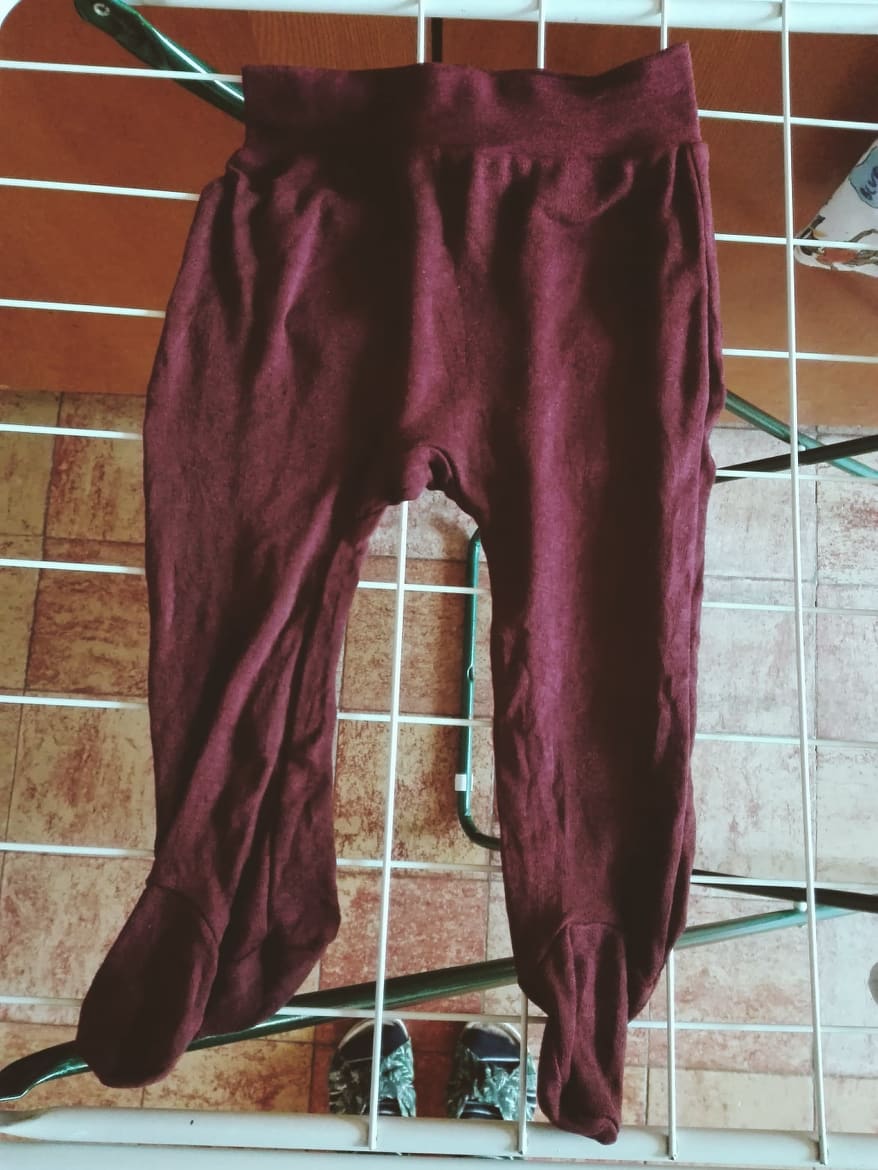
It was a purchase for 1 euro, which I dyed at home in the color for fabrics to have a little more contemporary color - not that white bothered me so much, but I just liked the idea of giving it a slightly earthier color. I mixed the black and red color from the DM drugstore and dyed my panties in burgundy color.
The question of camping with the child as such remained to be solved. What to do with him during the day? Let him crawl in the mud? The forecast for Libušín was not very promising, Frýdlant promised some sun, but to go around the marketplace and friends in the camp, I would still have to carry the baby in my hands anyway. To simplify the problem, I succumbed to the scarf that solved the situation most comfortably. Of course, I have been dealing with the period carrying of children for a long time, and this is also regularly addressed in the czech Facebook group “We carry children in the Middle Ages”, where many mothers devote themselves to the reconstruction of period carrying (even in the Thirty Years War, no matter what the name of group says).
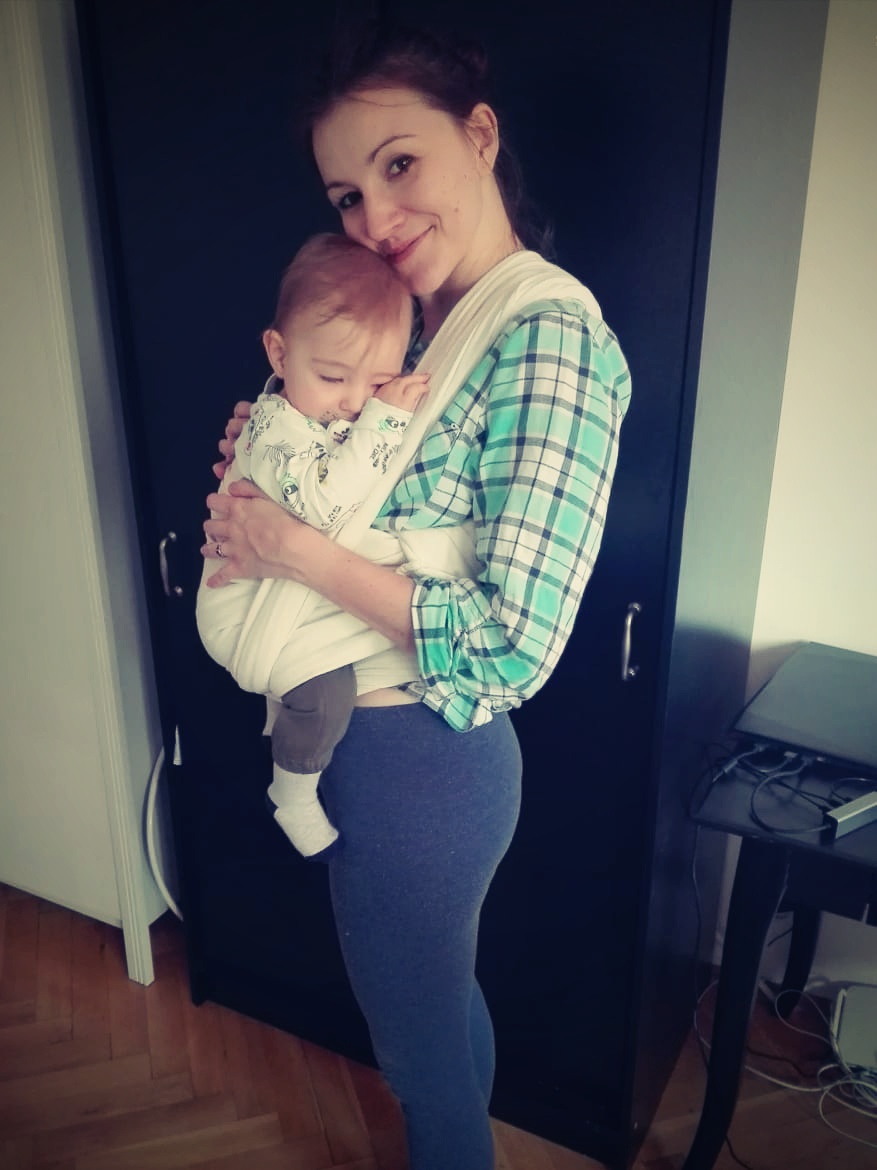
Although there is a lot of documentation of carrying of children and I tried a few of them, I chose the least authentic, contemporary, and for a simple reason - it was the most comfortable for me and the baby and I was used to carriyng him like that in a modern carrier. Our friend Anička lent us this one for Libušín, she has saved our participation. :)
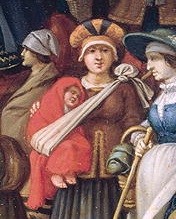
VRANCX, Sebastian. War Scene
Detail of mothers with children from Vrancx, wearing a knot on the shoulder is very strenuous for a back and I was a little bit scared about the safety of the child.
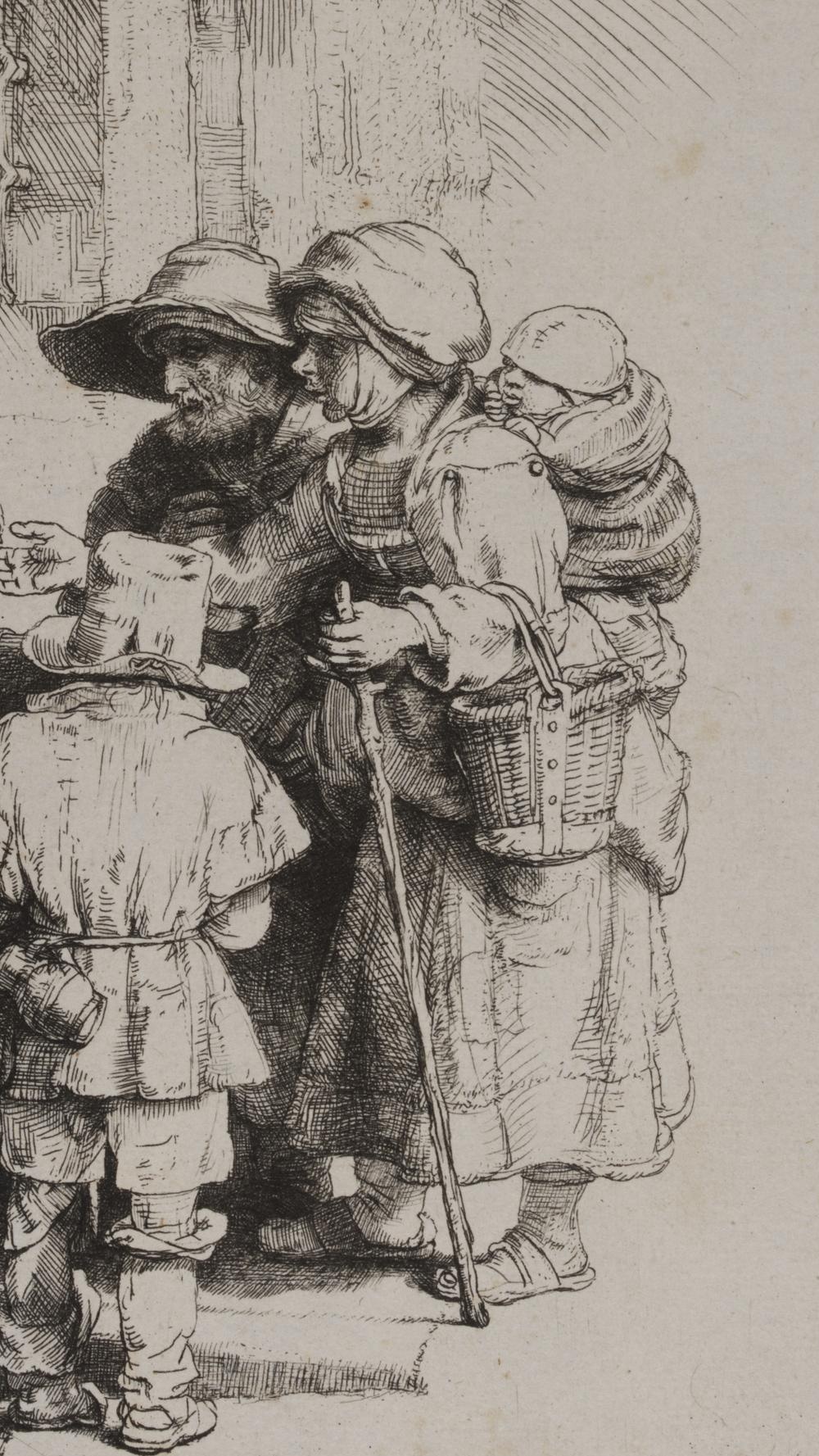
REMBRANDT, van Rijn. Beggars receiving alms at the door of a house
A baby on the mother´s back.

I was thinking also of a use of a pacifier. Although we have never used it much at home, we sometimes used it as a sleep assistant, otherwise we functioned without it. Originally I thought we wouldn't need it, and I wouldn't deal with it, but my husband was of the opinion that we were still taking a baby into something brand new, and maybe it would be good to have it. But the idea of having a pacifier with Mickey Mouse with the historical outfit I had made was simply unthinkable to me. So I insured myself with the other pacifier, knowing that he would probably have it for sleeping and in a tent.
I was thinking about making a historic pacifier first, but so far nothing seemed safe to me, and I don't really know if it would serve any purpose, since he´s not even used to the modern pacifier. What was I considering?
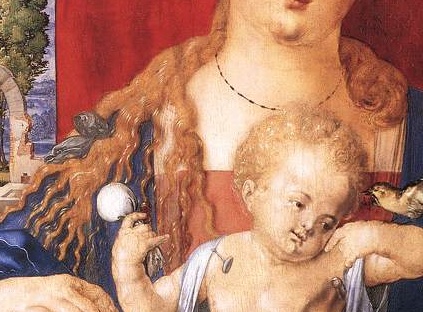
DÜRER, Albrecht. Madonna with the Siskin
A pacifier from Durer, or rather some calming pouch.
Honestly, I haven't researched the pacifier history so much, I know something from the little I've read on Wikipedia and peeked out from Pinterest. Since I read on Wikipedia that the first pacifier, as we know it in its present form, was invented in 1901, I did not deal with its historical appearance much, because we probably had it as extra accessories. I had the pacifier tied to the string so that we wouldn't lose it, and I was content with EcoViking, which was used once in the tent when the little one fell asleep at Libušín.
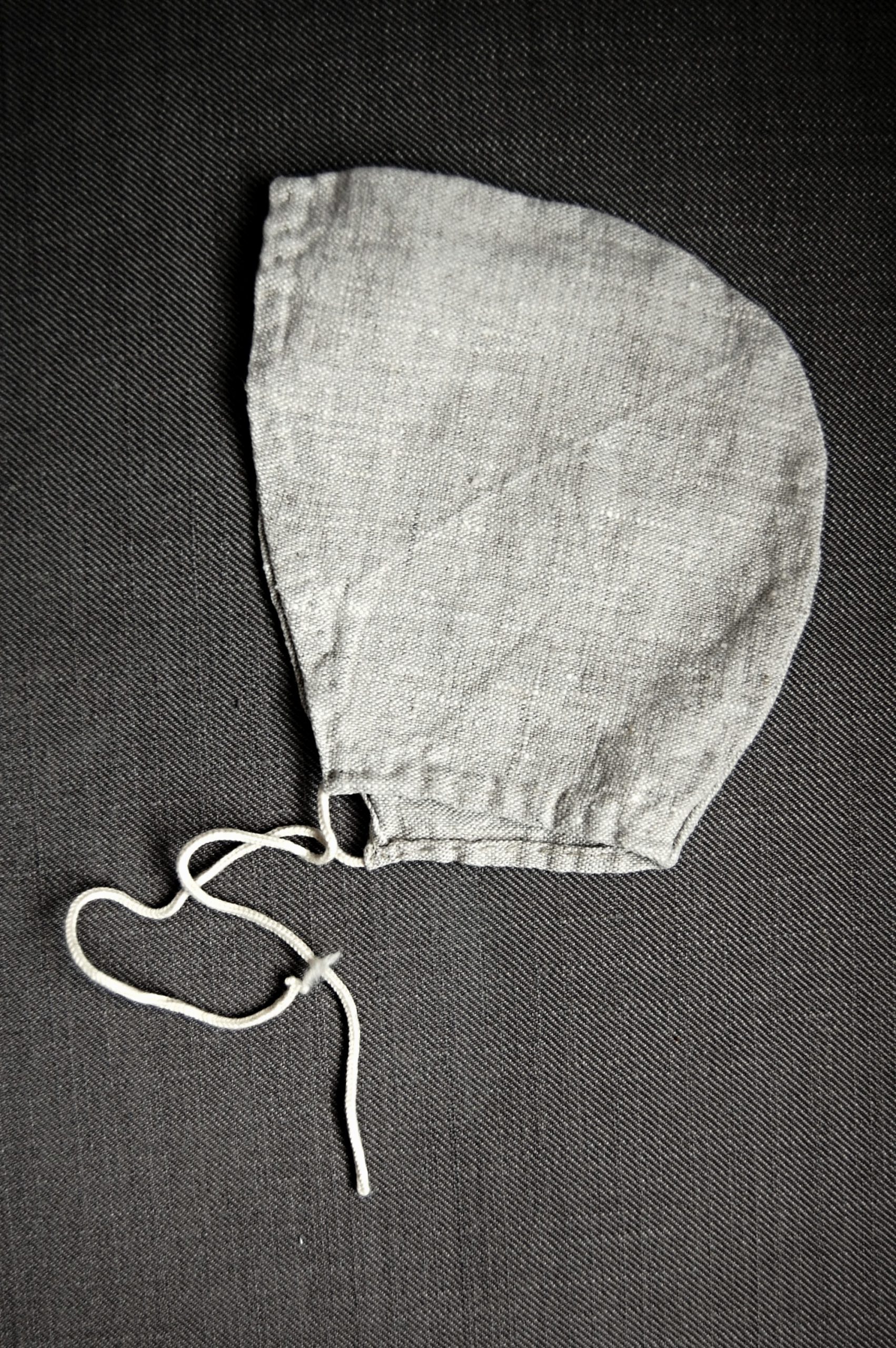
In the evening before the event I sewed a linen cap...
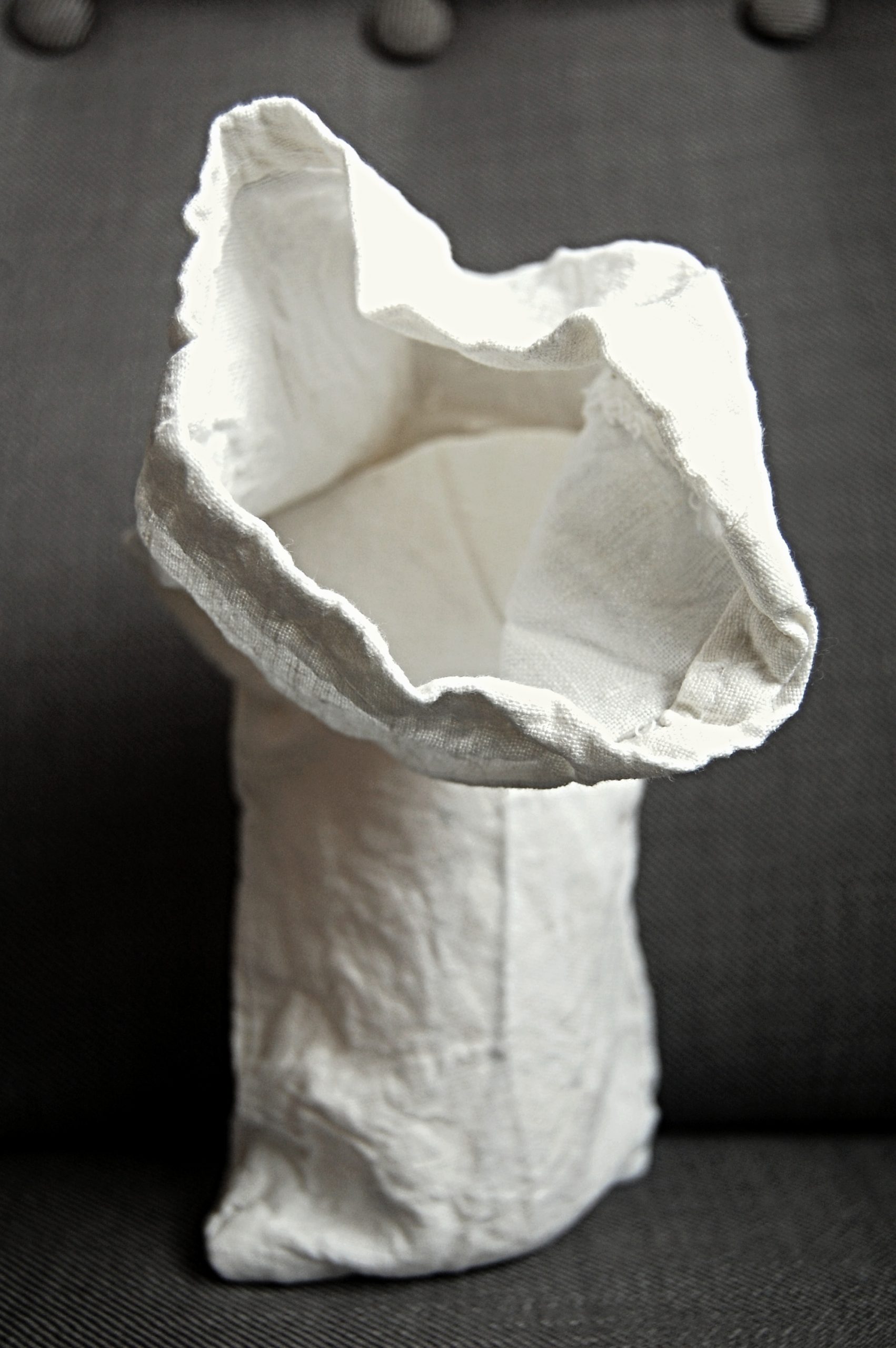
...and a bag for hiding a baby bottle when my little one drinks his favorite smoothie. :)
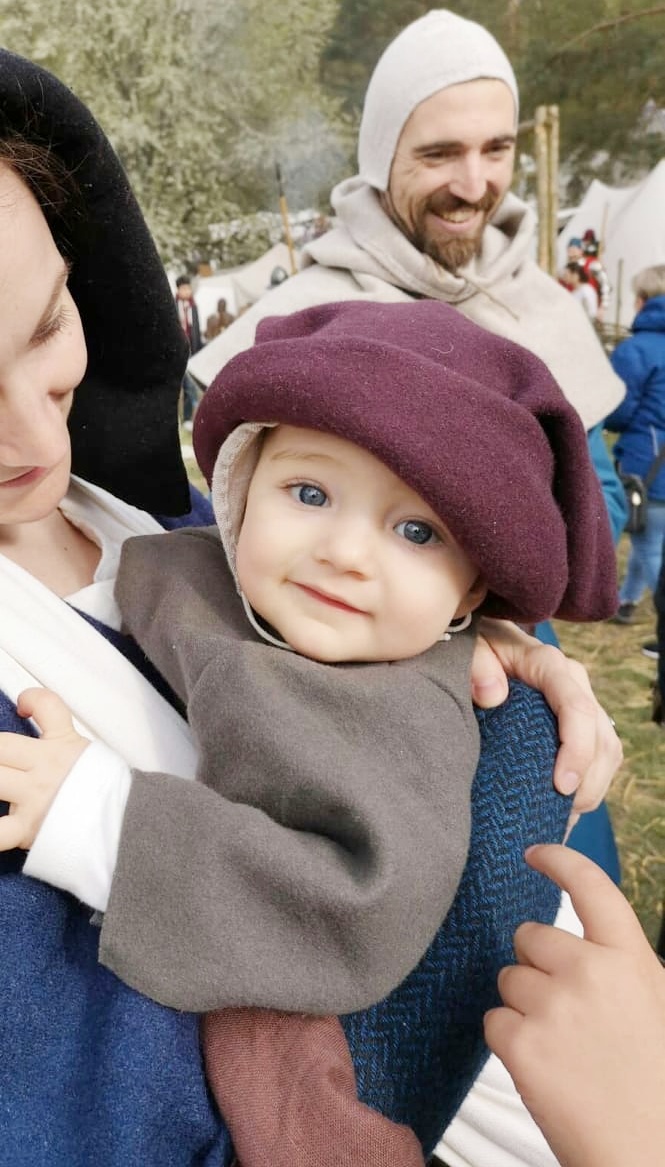
Libušín 2019 (woolen hat from my husband due to the rain, it´s not part of the children's outfit).
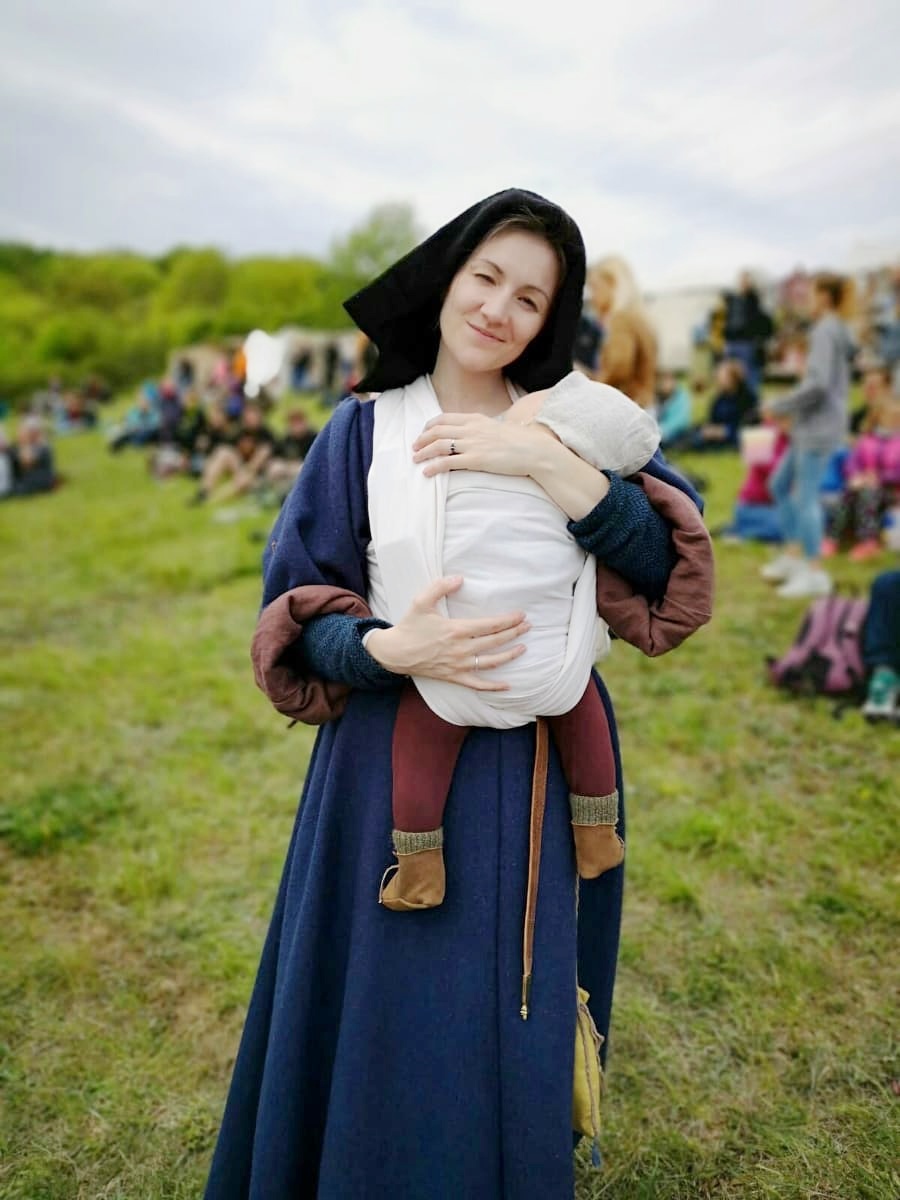
Since I had the scarf for the first time in my life, I learned to tie it actually at the event, which resulted in a tightening error and experienced mothers will recognize at first glance that the baby's legs are hanging too much. Fortunately, we soon rectified this mistake, the training of carrying the baby for almost the whole day at one event gave me a lot, uf. :)
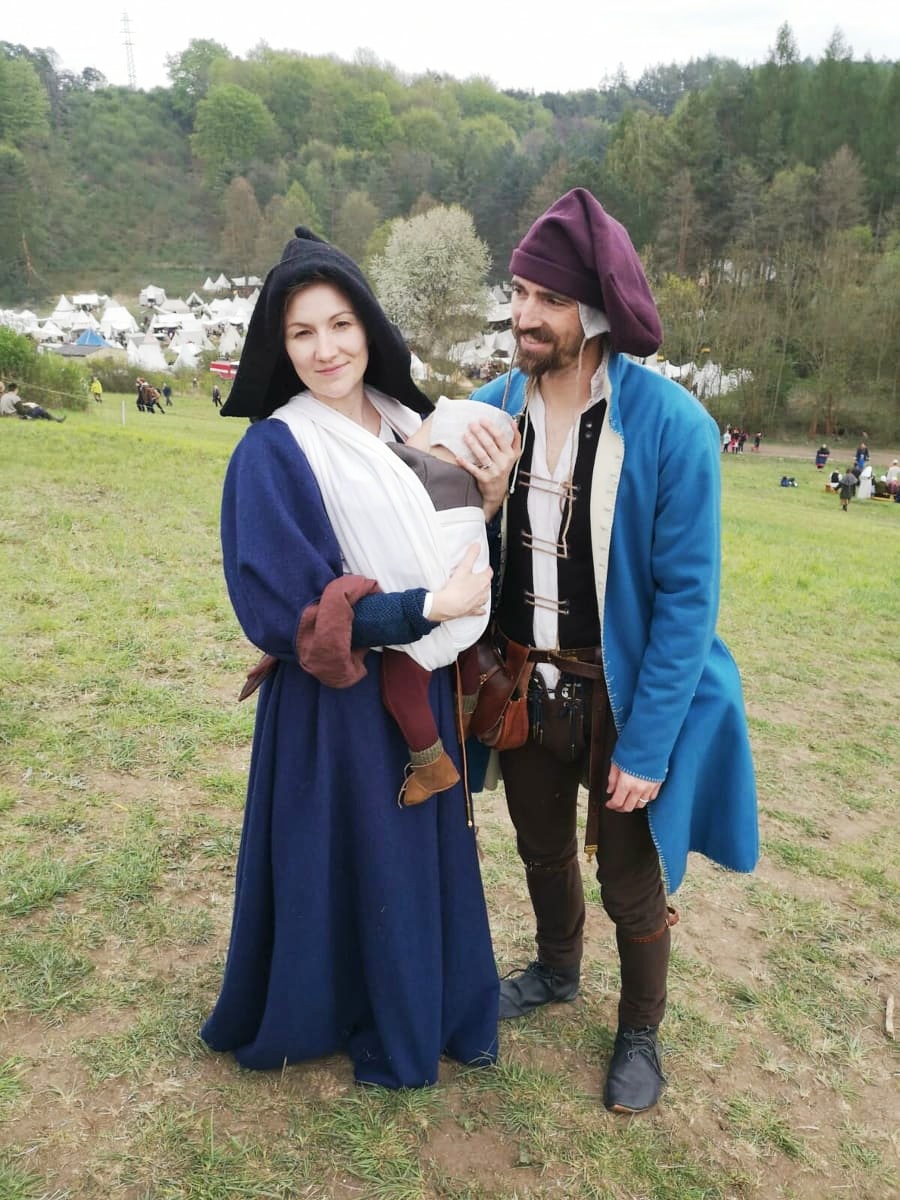
15th century family idyll…
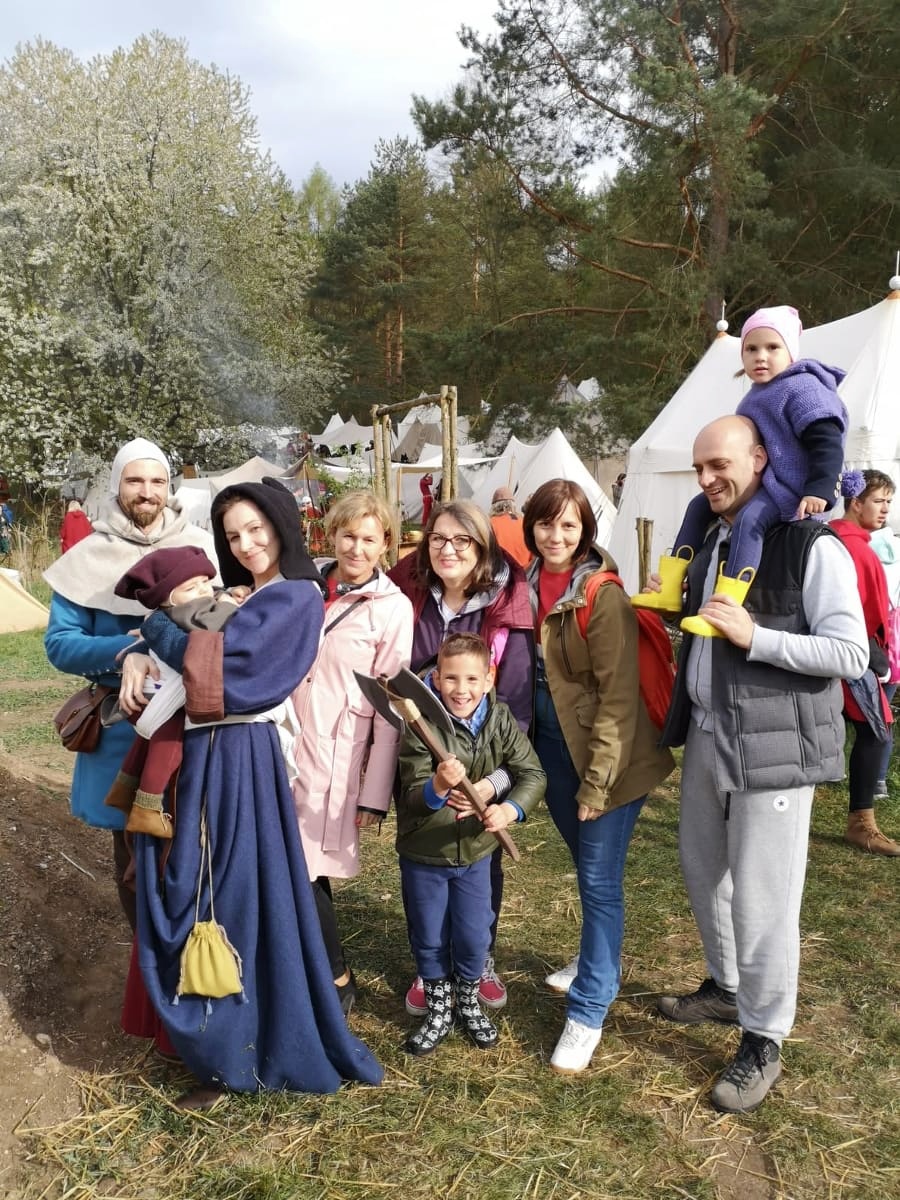
And this is how it looks when a family from Serbia comes to visit you at Libušín. :)

It should be noted that our baby slept half a day in a scarf, so our starting outfit seemed to be very comfortable.

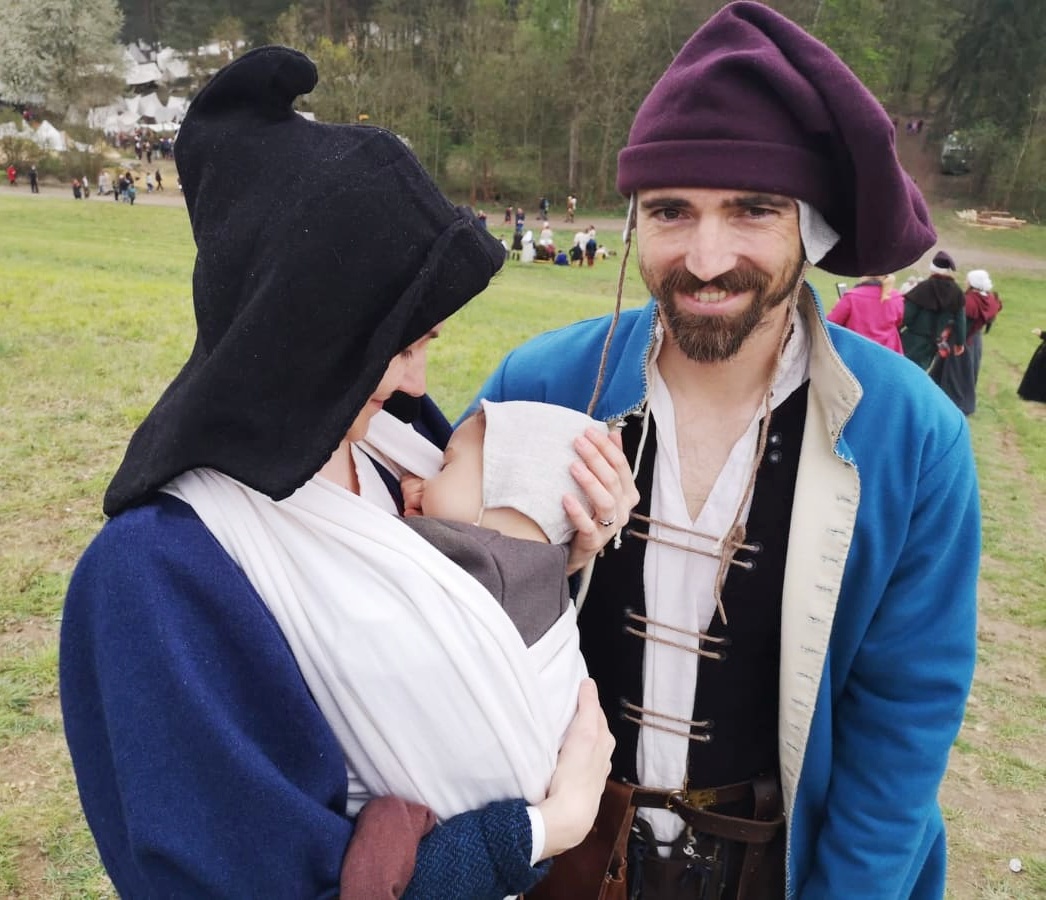
Thanks to the scarf, the baby did not even have to be dressed up so much - under the warm coat the baby had only a body and panties, the rest was taken care of with mutual warming. The scarf is also quite practical for covering or lining of the basket.
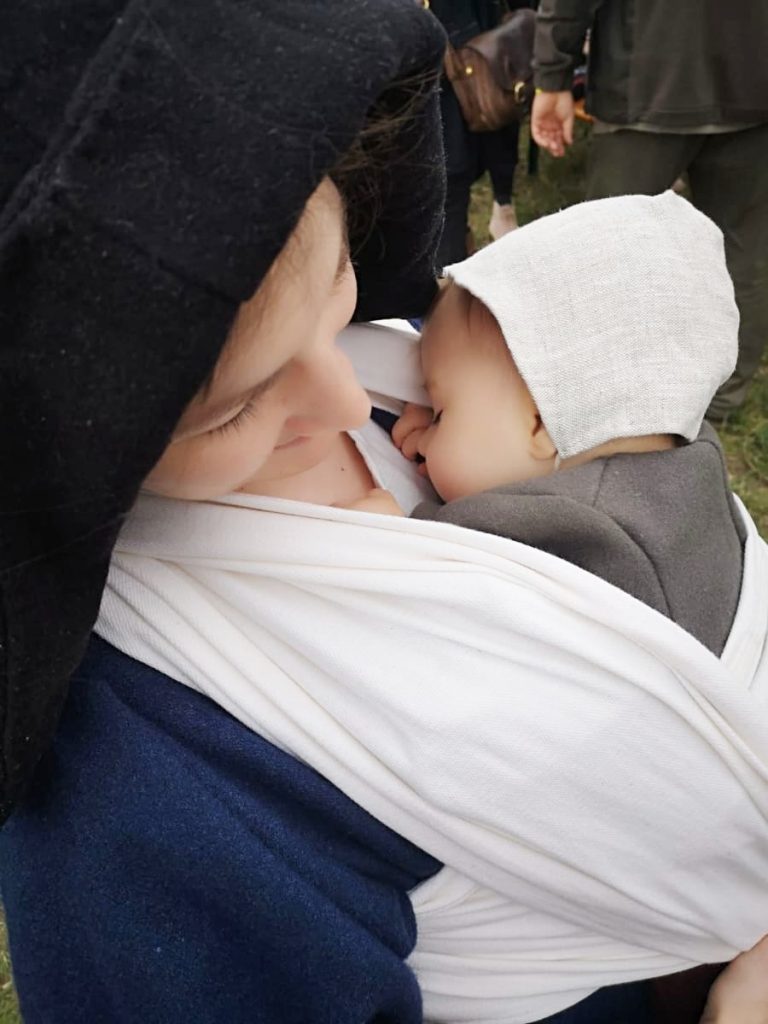
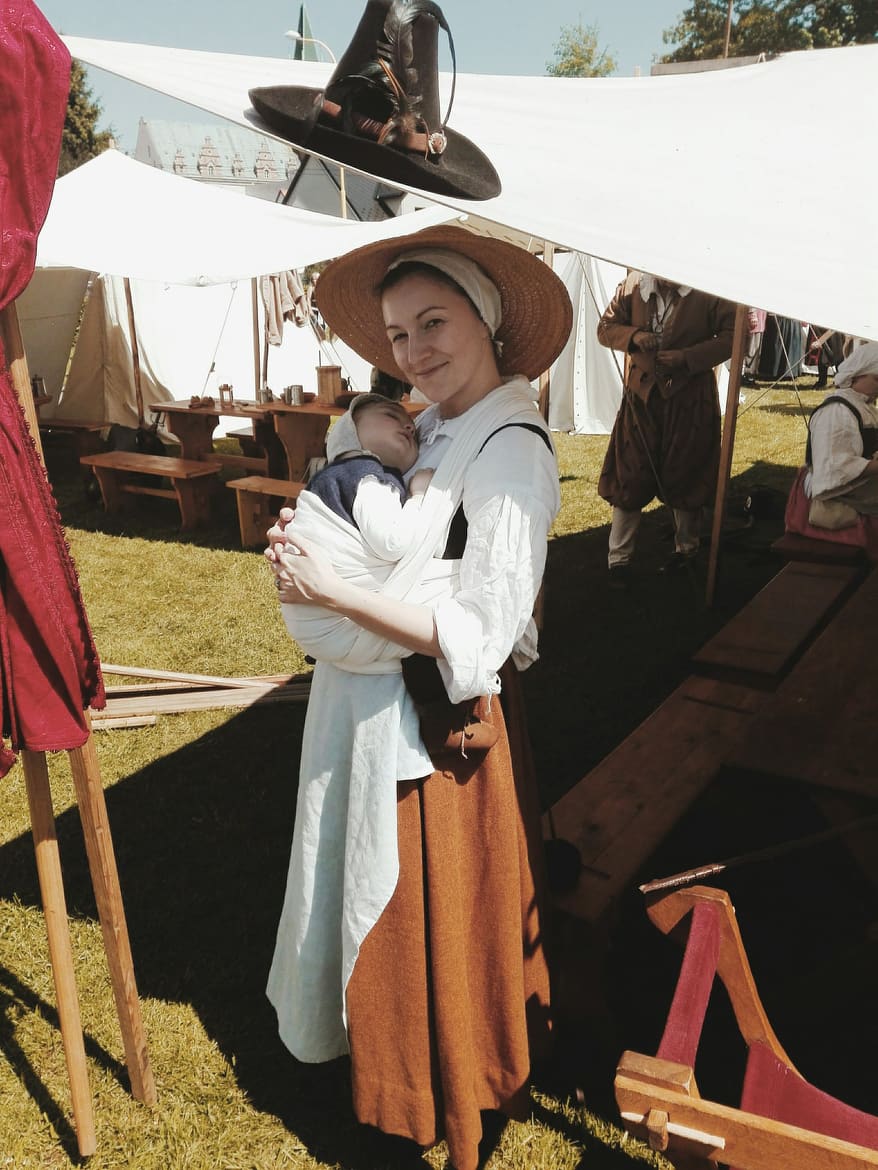
Wallenstein Festival in Frýdlant 2019 and again sleeping baby in a scarf, this time in his petticoat. Apparently again fully satisfied. This time we had our scarf. The scarf is made of 100% cotton, in natural ecru color, woven with a twill weave - it was the most sensible choice if you don´t want to disturb the timelessness.

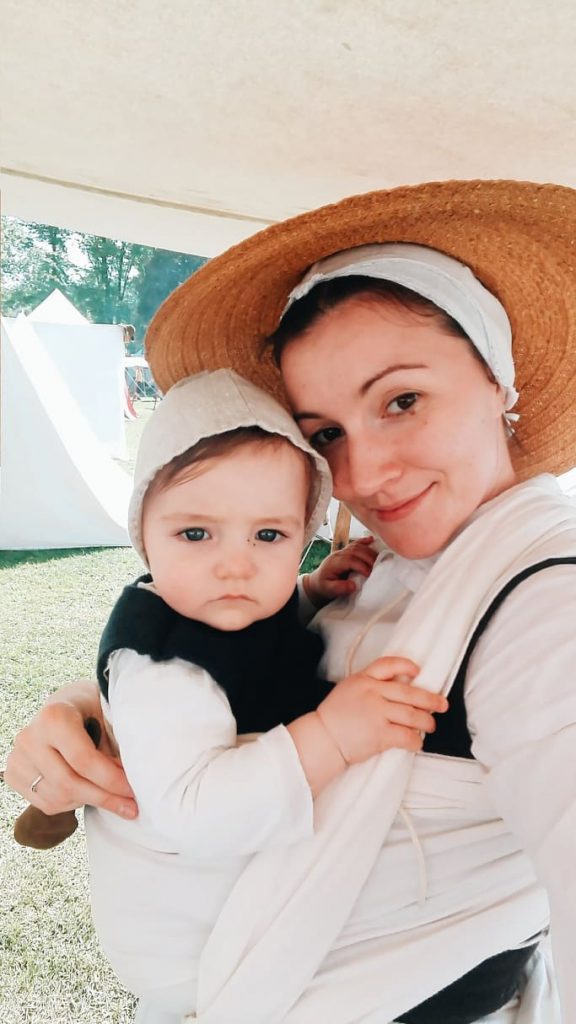
What did I use?
For the coat:
For the petticoat:
- Medium thick dark blue 100% wool from Wooltrade
- Dark blue cotton thread
- Dark blue blacksmith thread
- White 100% linen, leftovers
- Brass wire from Korálkárna for making hooks and eyes
For accessories:
- For cap: natural 100% linen from Sartor + merino natural wool for luccet cords
- For gloves: old 100% wool sweater + brown wool for luccet cord
- For shoes: leather remnants (I used an old dad's jacket)
- For the bottle´s bag: the remnants of the white linen
Non-products:
- Warm knitted wool socks
- Pepco cotton panties colored in burgundy color
- Old white chemise and classic white cotton body
- Wooden baby bowl
- Baby spoon from LH shop
- Inherited laundry basket
- Wool blanket for the basket
- Scarf for carrying baby
- Pacifier
What will I do differently next time?
- While sewing the shoes, I apparently for a moment forgot myself, and made both left-to-right, I noticed that after completing them, probably accustomed to the left-to-right shoes - for such a small child of course it does not matter at all, especially when they are more like slippers, but the pattern is made on each leg separately, shoes should not be the same according to the pattern
- I´ll make a chemise or two, of course
Highlights:
- For such a small child, it is best to create a growing costume which may be a bit baggy at the beginning, but in the end it is really practical - sleeves can be rolled up, or just like the length of the whole costume they can be more folded and only slightly extended at the hem after some time
- It is important to think about safety - do not use materials that are easily pilling to keep the baby from choking, buttons and other fasteners or laces sew tightly and choose a material that will not be harmful when bitten and licked
- Of course always have backup clothes
